ICHNOLOGY-the
study of animal traces (tracks, burrows, etc.) Page 3
This page was born 06/12/2023. Rickubis designed
it. (split it off from an older page.) Last update: 02/21/2025
Images and contents on this
page copyright ©2001-2023 Richard M. Dashnau
Go to
Ichnology page 2
Go to
Ichnology page 1
Go to
Ichnology
page 4 (this has the most recent observations).
Go back to my home page, Welcome to rickubis.com
Go back to
the RICKUBISCAM
page.
----------------------------------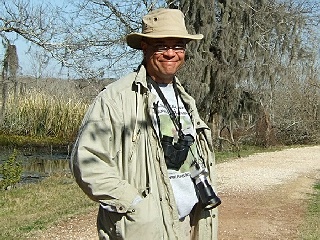
That's me on the 40-Acre Lake Trail at Brazos Bend
State Park (12/31/2007). I was waiting for an otter to show up.
It didn't.
Over the
years that I've been keeping these pages,
making new observations and learning new things, I have met
some interesting people.
Two
of them are Dr. Anthony Martin and Dr. Lisa Buckley.
They study ichnology--
animal traces. While the term is commonly used in
relation to fossils (such as dinosaur tracks), it also applies
to living creatures as well (sometimes called "neoichnology"
with "paleoichnology" for fossils). One major
aspect of this study is that such traces can show animal behavior. For
instance, a single footprint might not say much, except
what kind of animal made it; but a series them might tell
if the animal was running, or jumping etc. There are
three basic factors that help to interpret traces: A)
Substrate (the
material that holds the trace) ; B) Anatomy (the part of the
animal that affected the substrate) and C) Behavior (what the
animal was doing with the anatomy that affected the
substrate). (see "The Three Pillars of Ichnologic
Wisdom" page 9 in Life Traces of the Georgia Coast by
Anthony J. Martin) I admit that I am not very good at
finding and
interpreting such traces. But, it is still fun to look and try
to piece together the mystery of what transpired at that spot
before I got there. I usually capture images of animals
activity. But every now and then I've taken pictures of
traces. I'll begin collecting them here. I will
eventually arrange them in chronogical order of some kind.
Many, many
thanks to Dr. Martin and Dr. Buckley for many conversations
via email and online; and for being supportive of my
amateurish efforts.
One more
thing: Although alligator burrows (or dens) and nests would be
considered ichnological traces. I've only got one example of
an alligator den on this page. I have
many observations of alligator dens, and have already gathered
them onto other pages, starting here.
This
page is arranged with the newest entries at the top.
05/27/2023 I went to Scobee Field to
see what the rain a few weeks before might have affected. The area
was mostly dry, although there was a little bit of
water in the ditches near the road. I examined the dried ditches
to see what sort of burrows were left, and I found another example
of an Apple Snail in a burrow! Although
they live in water, Apple Snails can aestivate in mud during dry
periods for 10 months! For more about Apple Snails (Pomacea sp.)
you can visit my snail page here.
There were a few egg masses on the culvert near the restrooms even
though the ditch was dry. So I knew that adult snails had been
around. Then I saw this hole that
contained 2 snail shells.
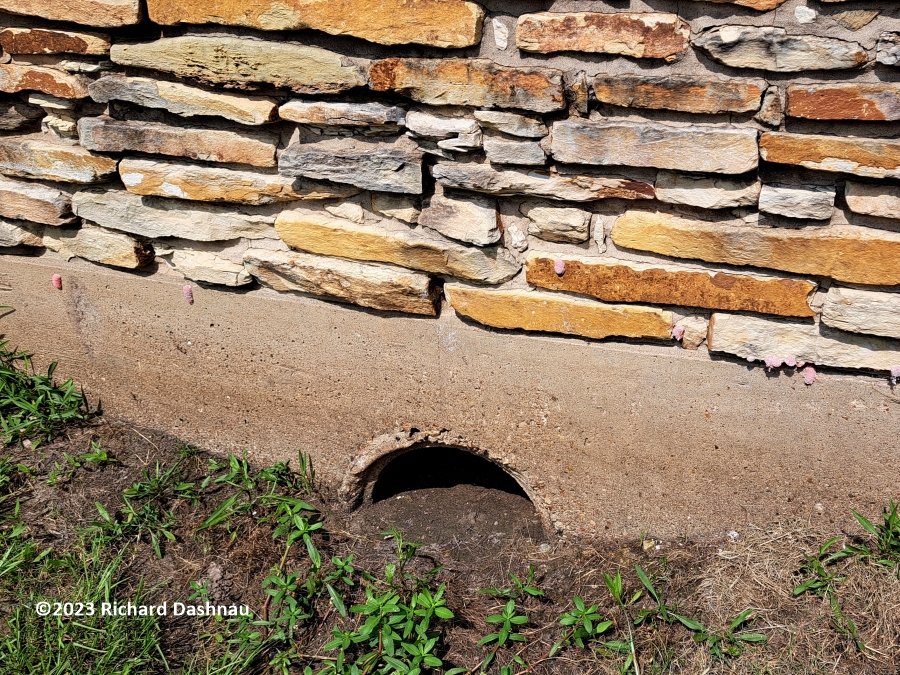
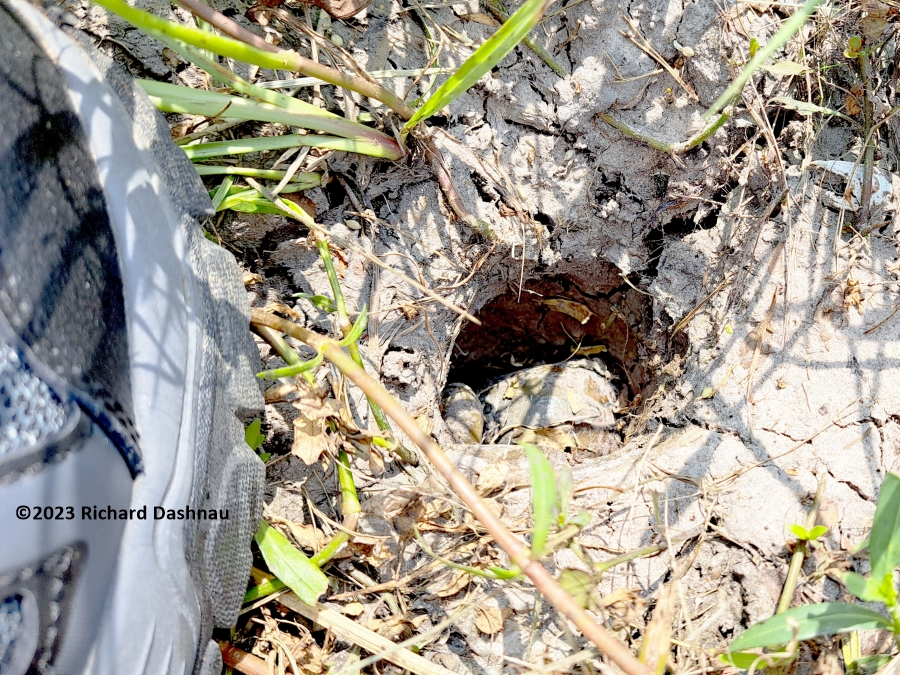
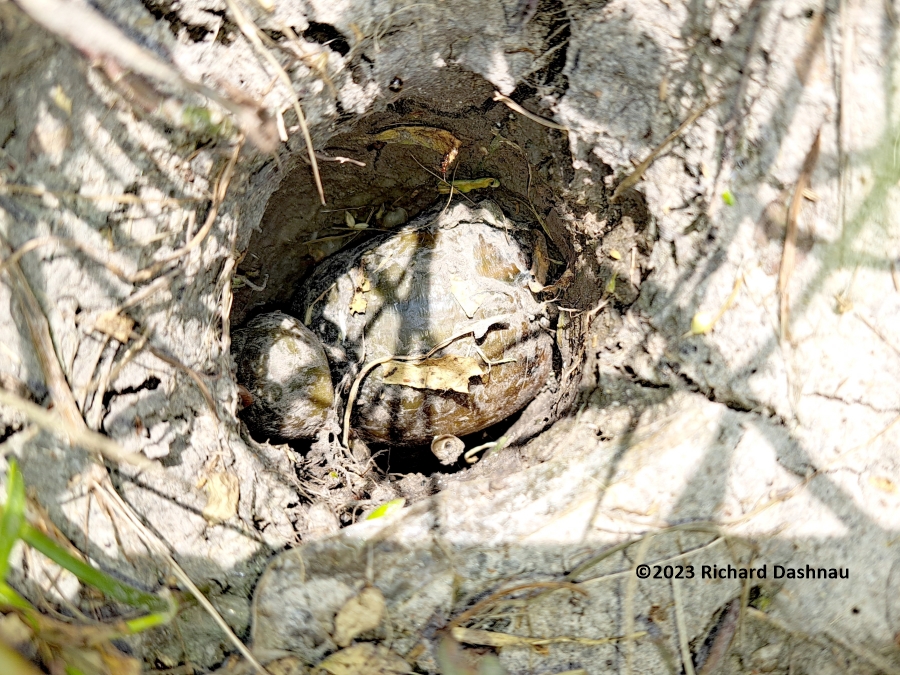
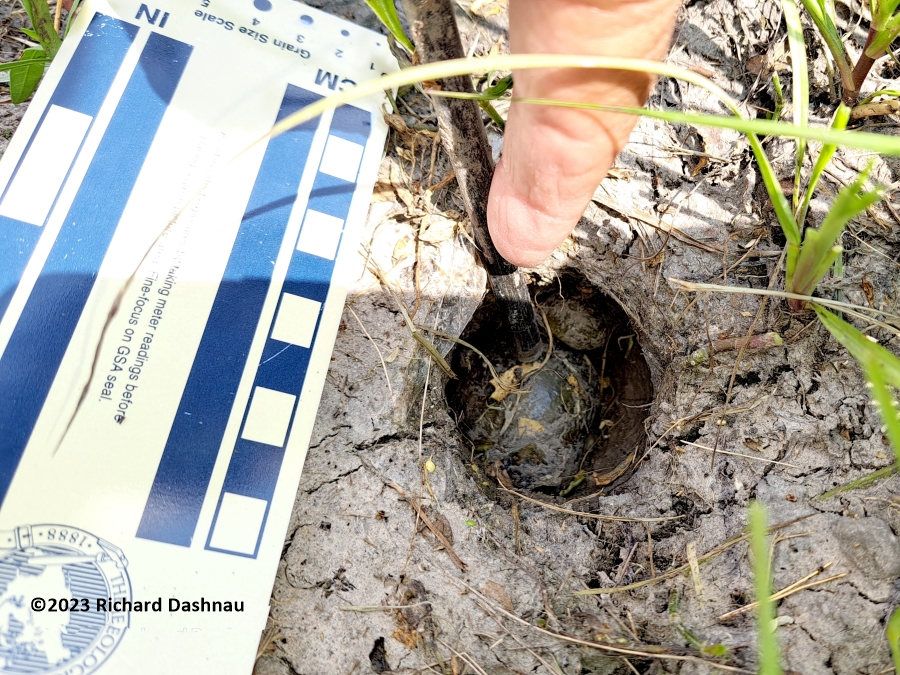
I
used a metal rod I'd found in the area to measure the depth to the
top of the snail shell--about 5 centimeters. When worked the snail
out of the hole (it was a tight fit), I
found that the snail was alive. The operculum was sealed across
the shell opening and was being held tightly closed. I was
taking pictures with my phone, and in the
bright sunlight it was hard to focus into the hole. But I got a
few, that show the bottom was rounded across the width, and pretty
smooth. How does an Apple Snail dig,
anyway? Of course, the hole was dug while the bottom was still
soft, as the water was evaporating. The snail was about
5cm...long?
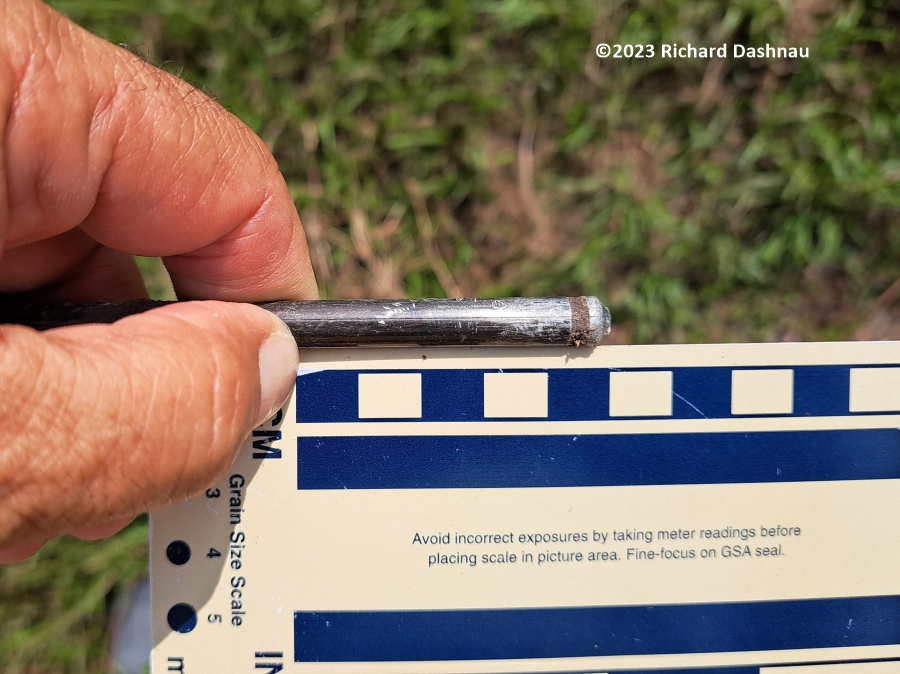
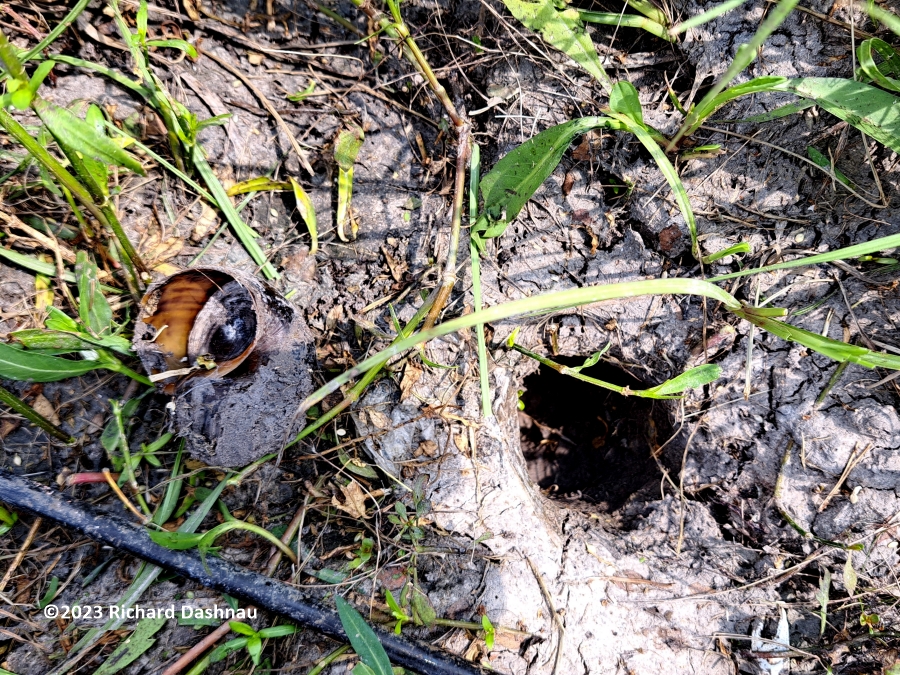
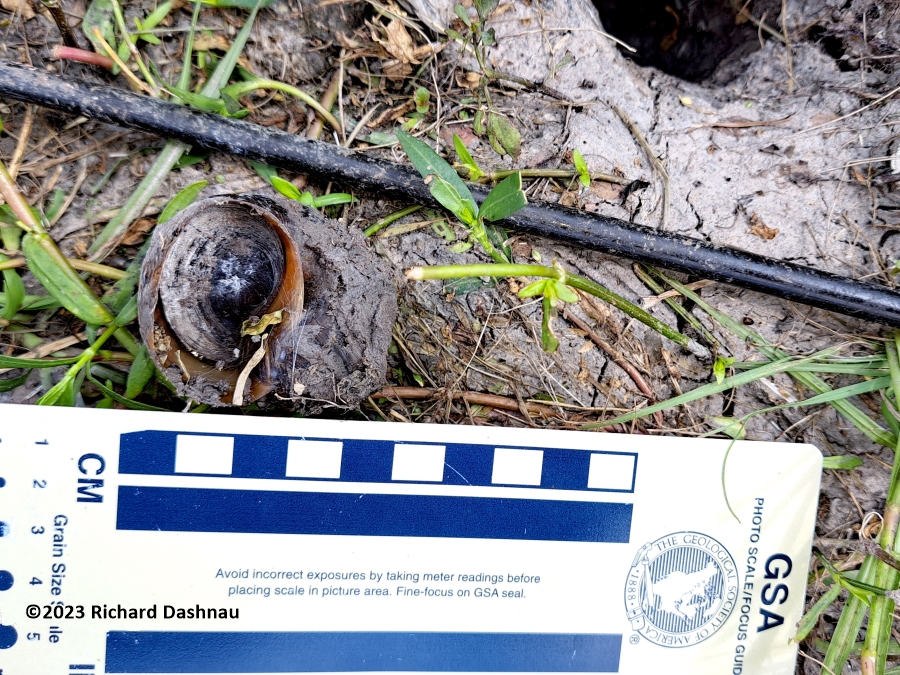
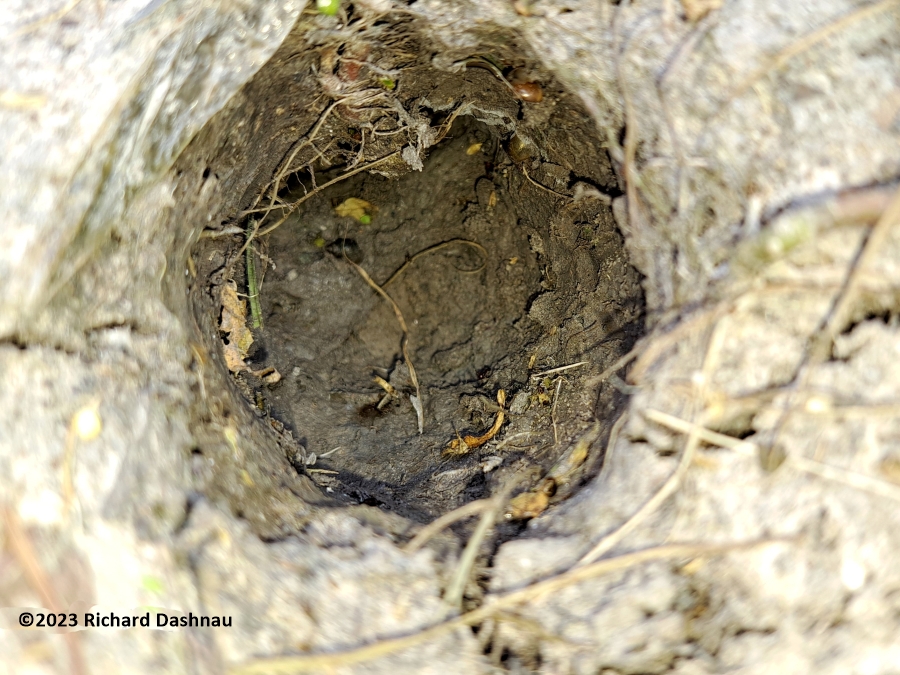
The hole was
about 5-1/2 cm across (of course, snail sized). I used the same
rod to measure the depth of the hole--about 9cm! I still can't
find any images of Apple Snail
burrows anywhere online (although I can find mention that they do
burrow to aestivate). This is my second direct observation of an
Apple Snail in a burrow. The first one
was also at Scobee Field, and is shown on my my snail
page here , as well as one of my ichnology
(animal
traces) pages here.
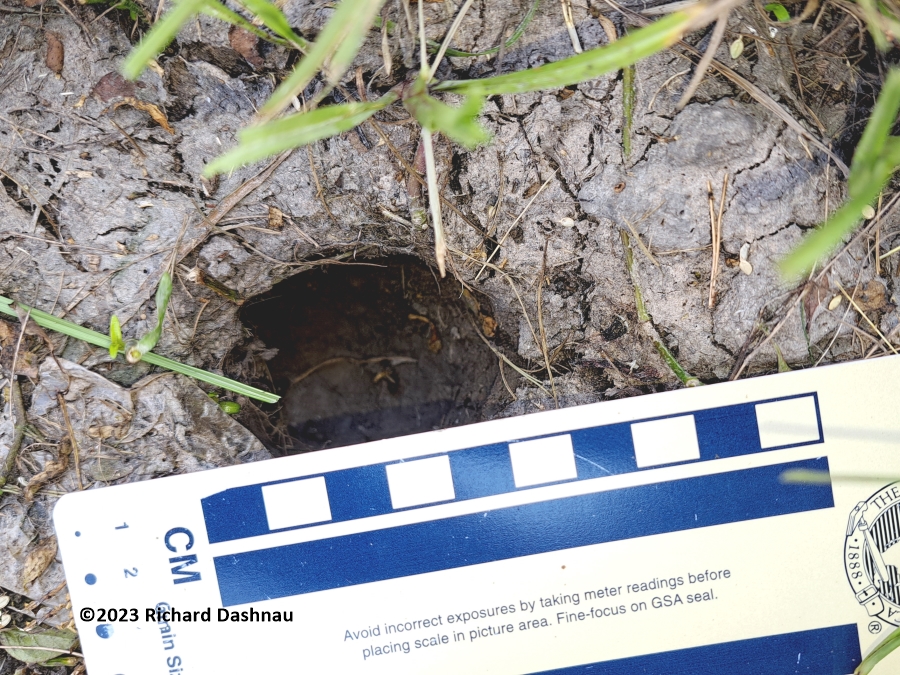
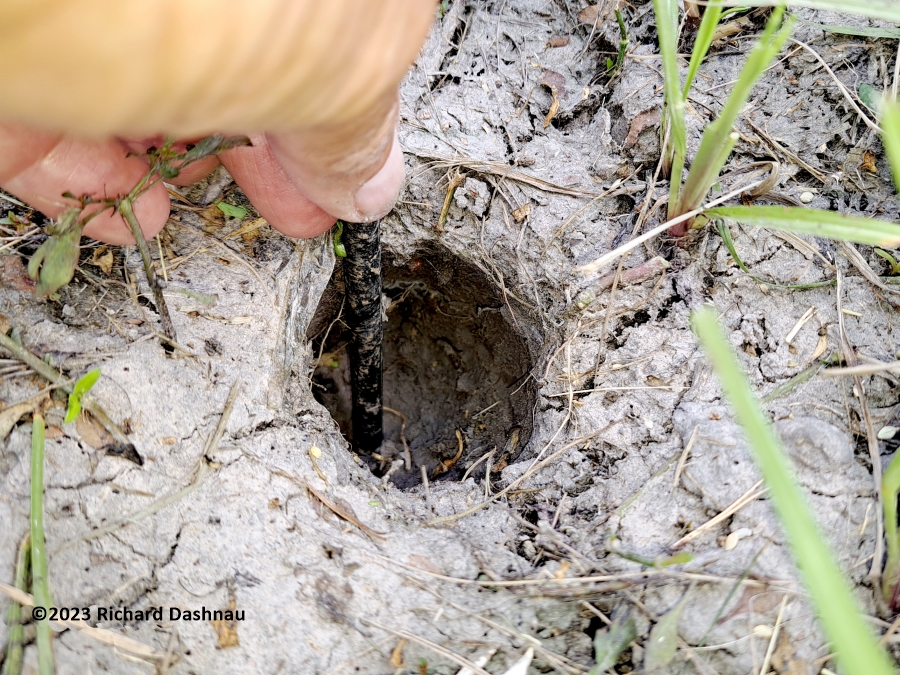
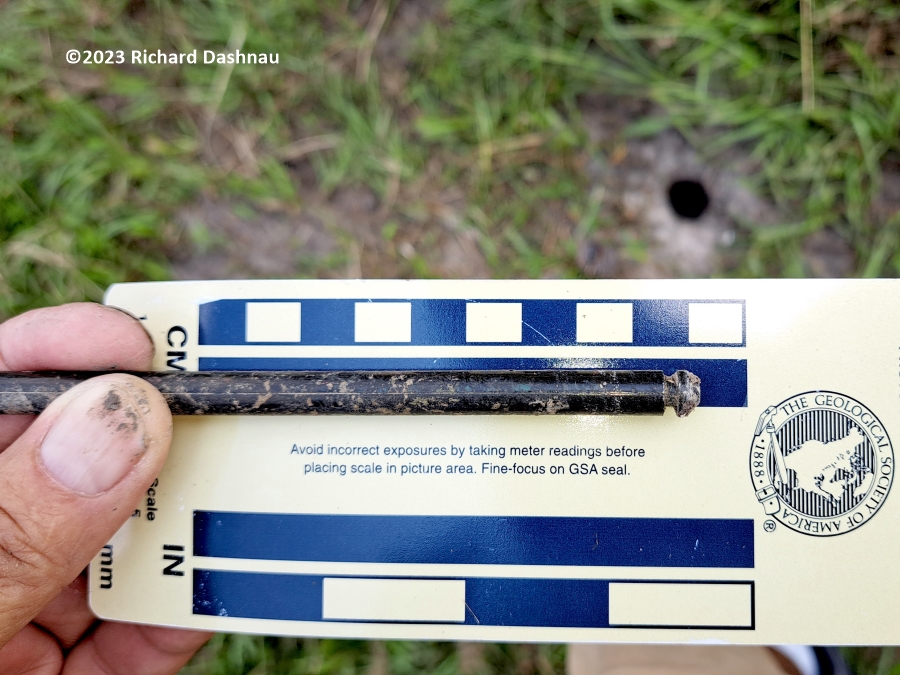
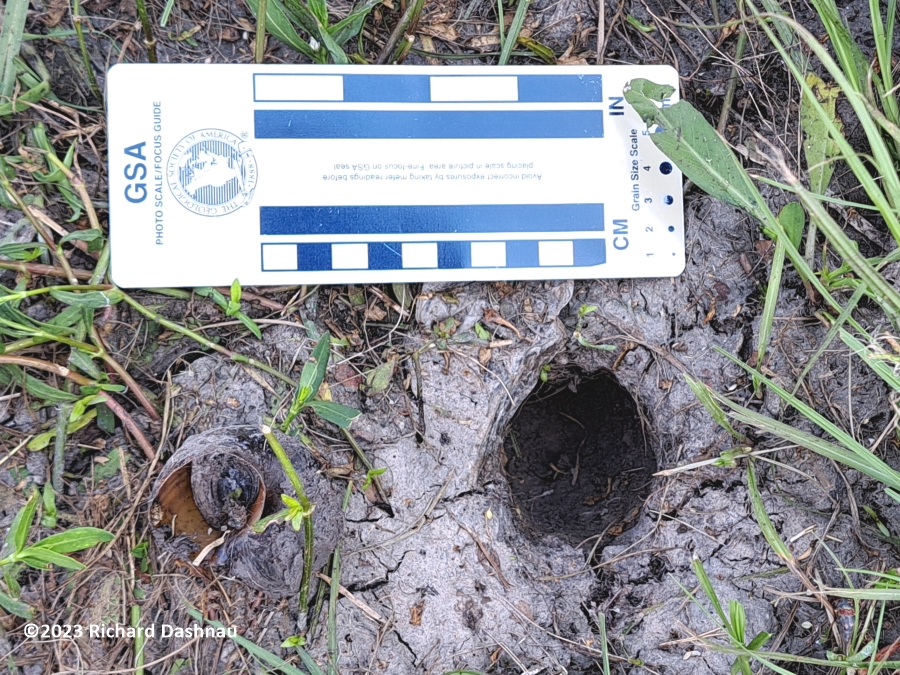
On
01/08/2023 I was at BBSP, and it was
an interesting day. It had been raining at the park. Many
of the trails are covered with a crushed-stone material.
When we get
the correct type of rain, water collects on the trails,
and the lighter materials in the trail-the tiniest
grains-work out and then settle on the low spots. This
leaves sections of fine-grained mud that
are good for collecting footprints. The best time to
see footprints on the trails in BBSP is early morning.
There are two reasons for this: 1) When the sun is
low, the light makes such traces
easier to see. 2) Most footprints on the trails are
obliterated by traffic by the end of the day. There were
two sets of alligator tracks that morning. The first set
was from a larger gator and shows
the big four-toed rear feet, the smaller front feet, and a
good crease made by dragging the tail.

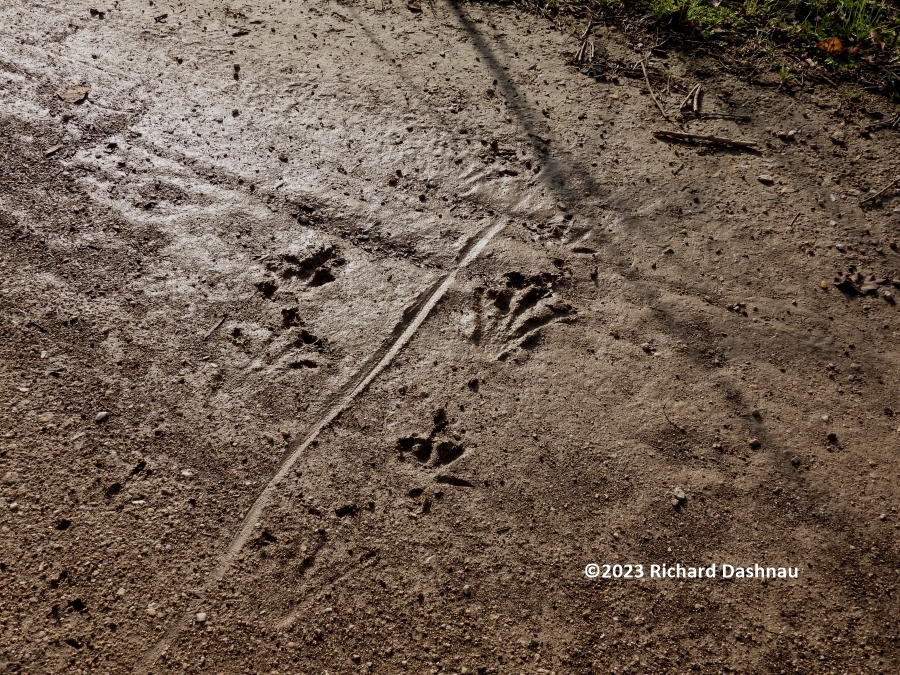
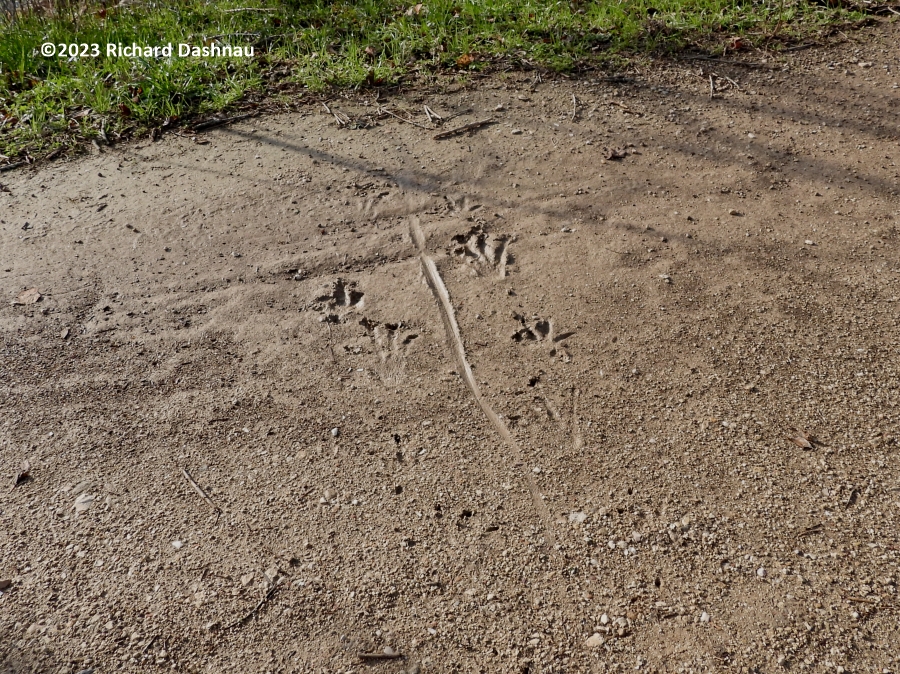
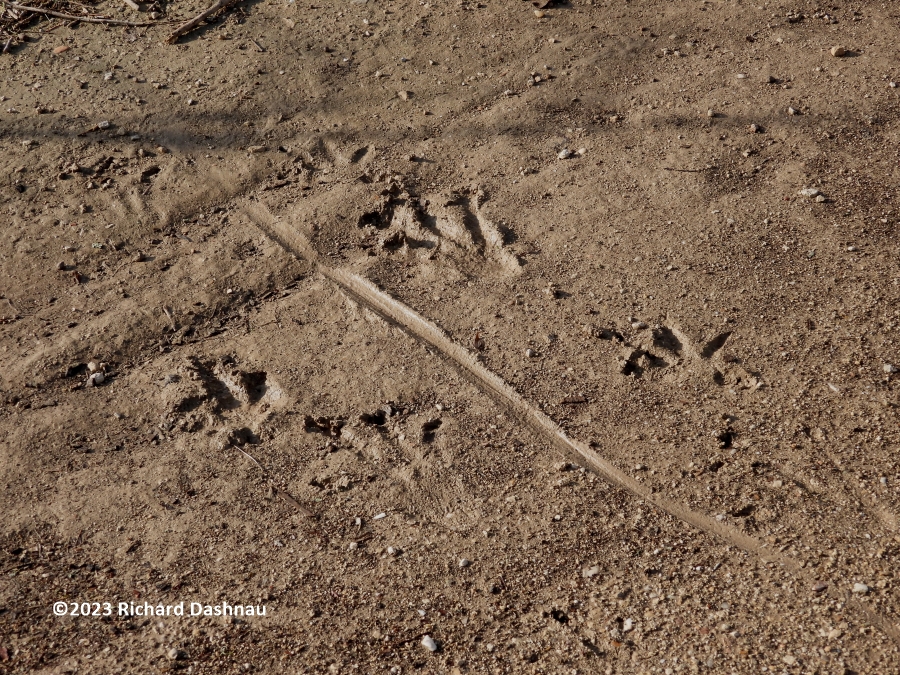
Another
set was from a smaller gator and shows a fainter trail,
but with some scale impressions captured in the
footprints.
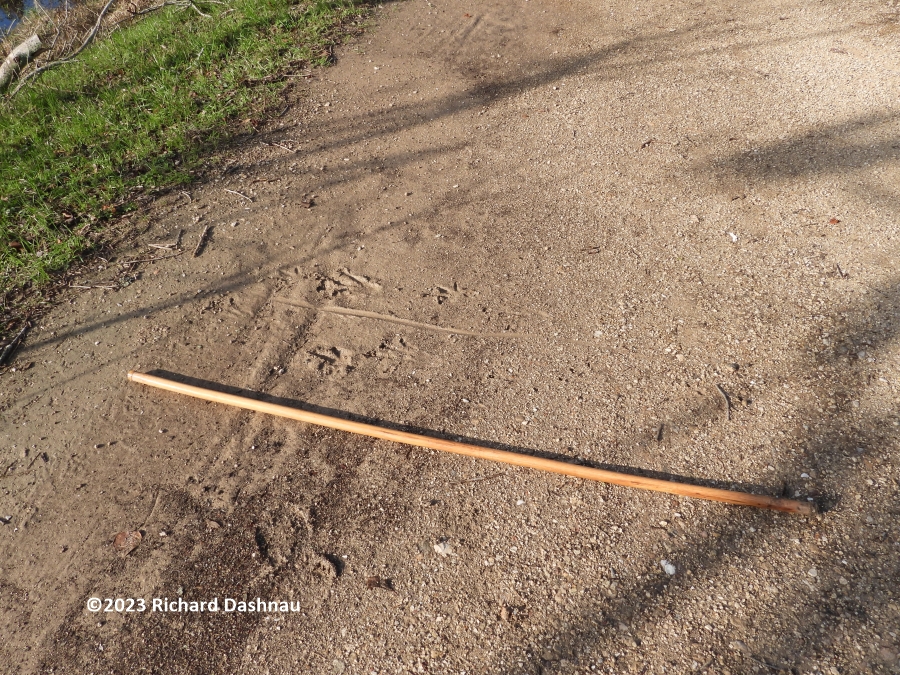
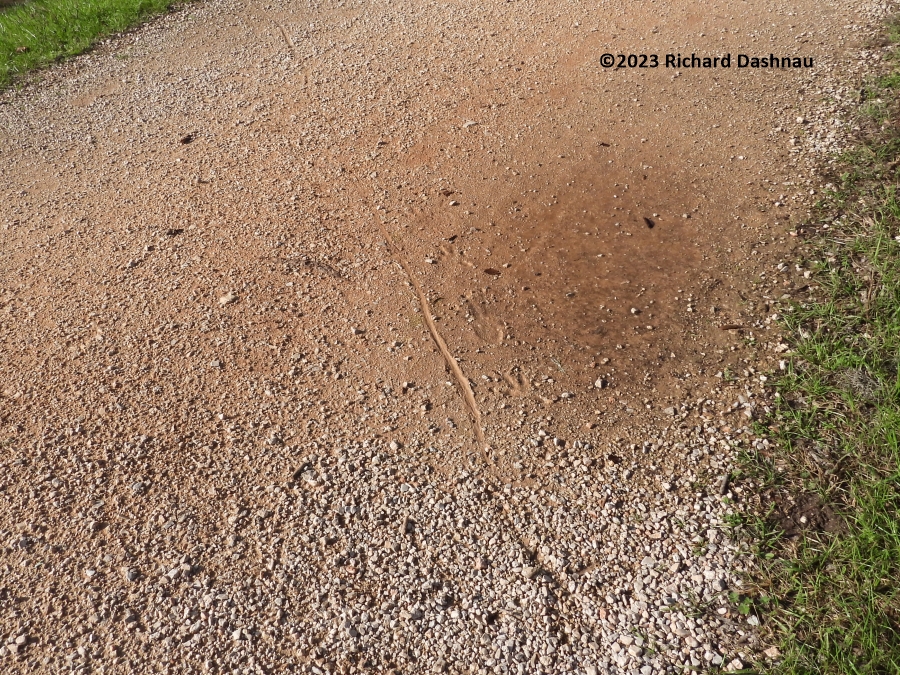
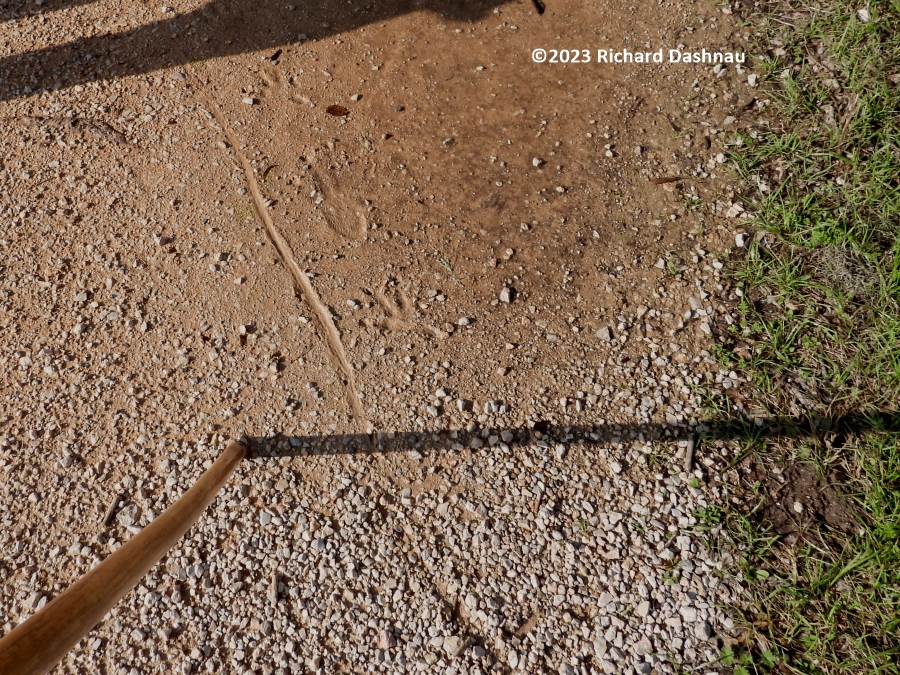
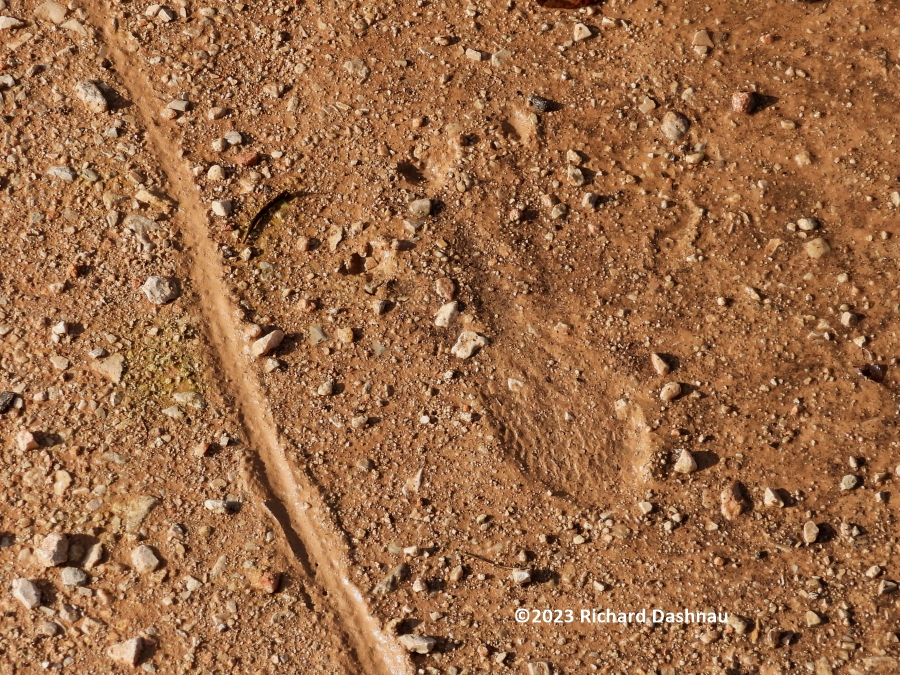
There were also these
mammal tracks. I always hope see Otter tracks, but I don't think an
Otter made these. No traces of claws or webbing, for one thing.
They are too big, and the wrong
shape for a Squirrels or Opossum. They aren't right for Nutria either.
Raccoons have a very clear "hand print" shape, so not that,
either. Armadillos might walk the trail, but I usually don't see
traces of them on the Spillway Trail. Also, Armadillos tend to bulldoze
through plant matter on the edges of the trails, and I didn't see any
evidence of that. Dog prints are more stretched
front-to-back, and usually show toenails, so I don't think they're
from a dog. The prints have a more "oval" shape, longer
side-to-side, with large middle pad. The front feet are slightly more
stretched. I believe these are cat prints...and a pretty large one,
since the prints are about 2 inches across. Maybe a bobcat made
them!

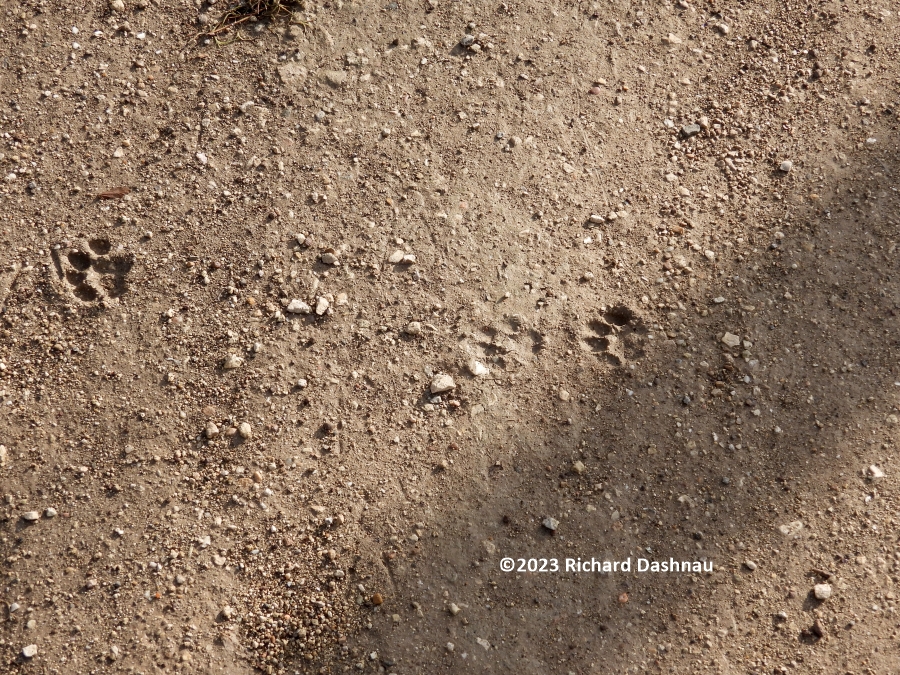
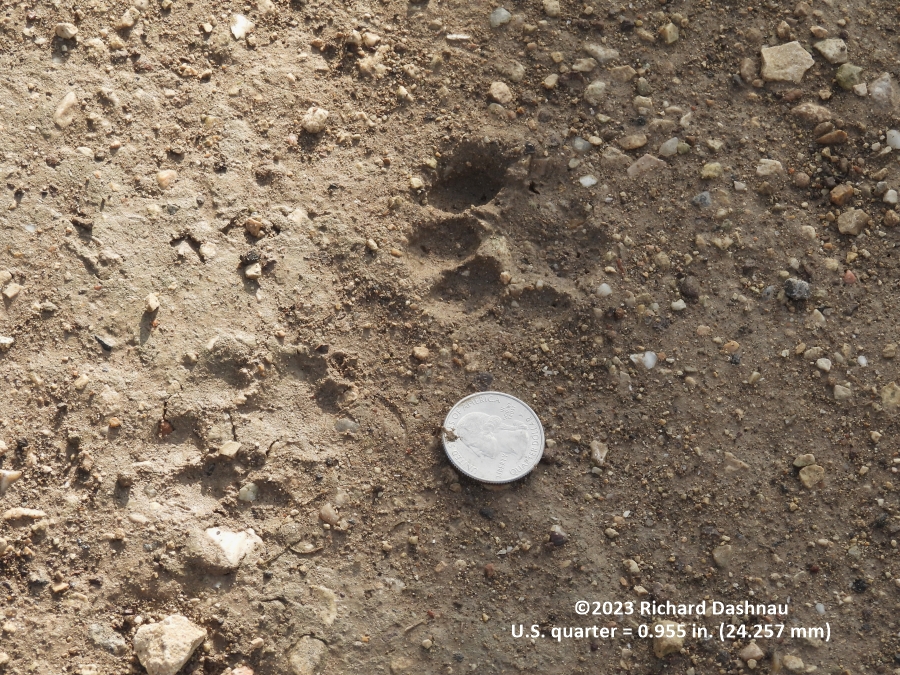
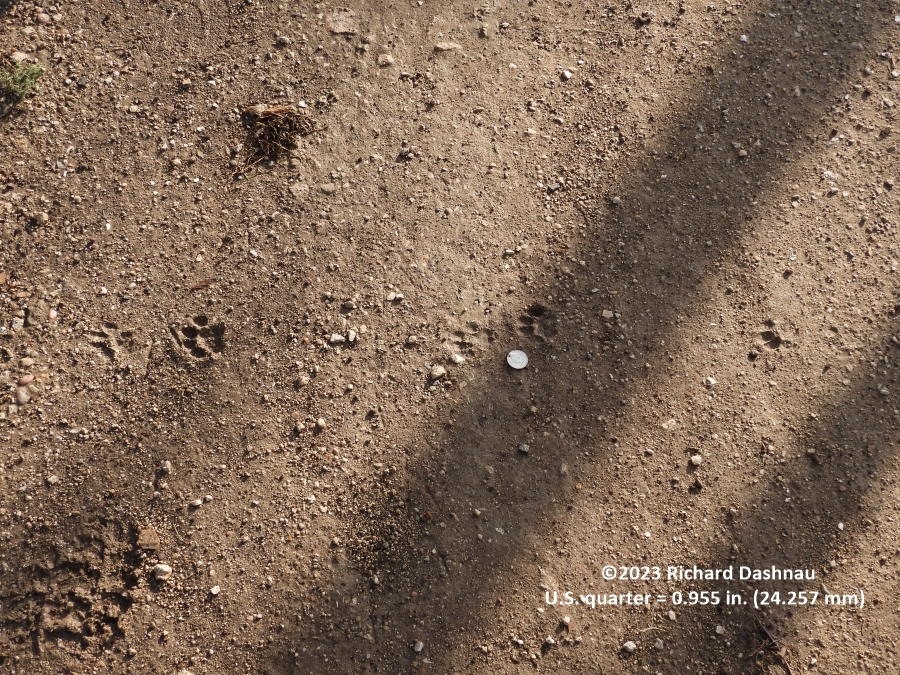
There were 2 sets
of prints at least 20 yards apart. This is the second set. The
prints are the same shape and size as in the first set. If they did come
from a Bobcat, then I might have just
missed seeing one walking along the Spillway Trail.
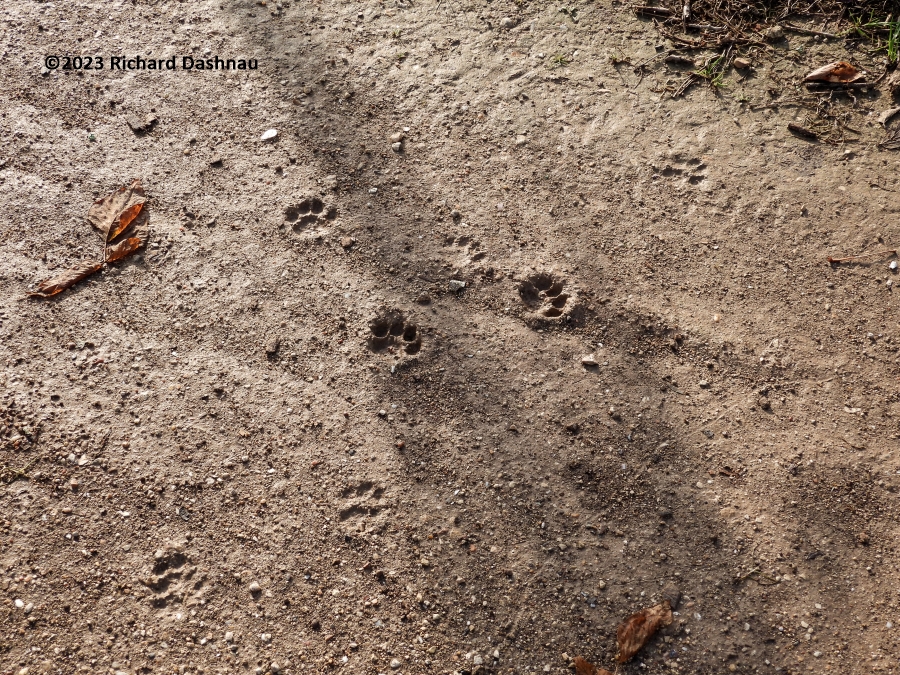
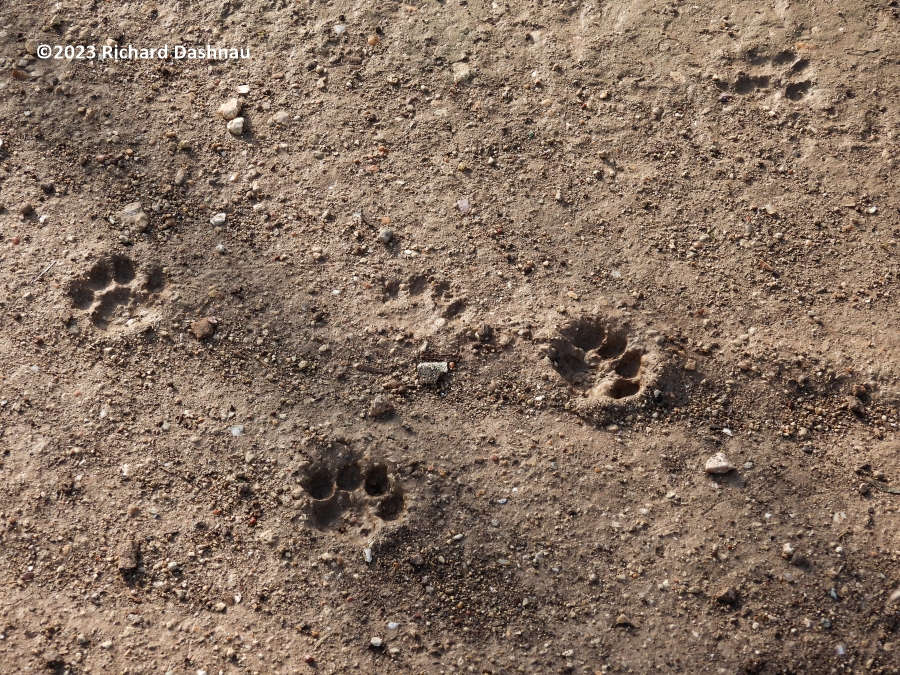

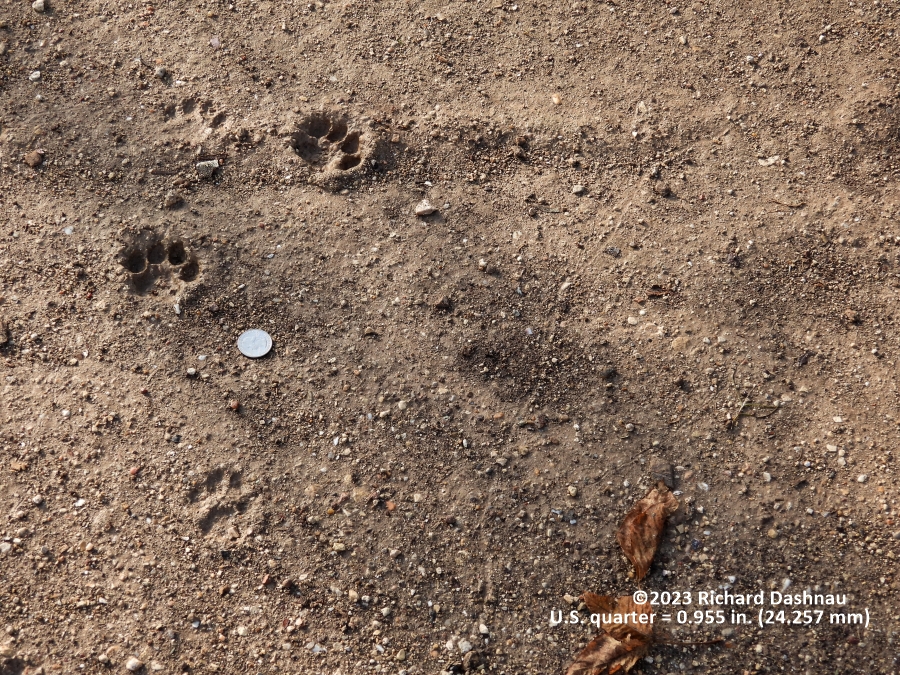
From BBSP on
07/03/2022
The water level drop in Pilant Lake has affected all kinds of
things. I've been curious about watching Gallinules using
their long toes to distribute their weight over
various substrates. On 7/03, I was able to get a close look at
Gallinule walking on the mud in Pilant Lake. The video
of this one walking, and the others chasing the Little Blue
Heron are in a video
and the video is here(mp4). The
images
below (and above) are frames from the video. The
video shows how resilient the mud surface was, as it flexed
and sprung back as the bird
walked on it. There were some footprints left, but only
faint ones, that probably would fade. Then, the Gallinule
stepped into softer mud, and it ran off, using the same
technique it would
use to run on water--flapping wings and running. That time it
left impressions, but the mud was too soft for them to last.
The arrows in the images point to the footprints.
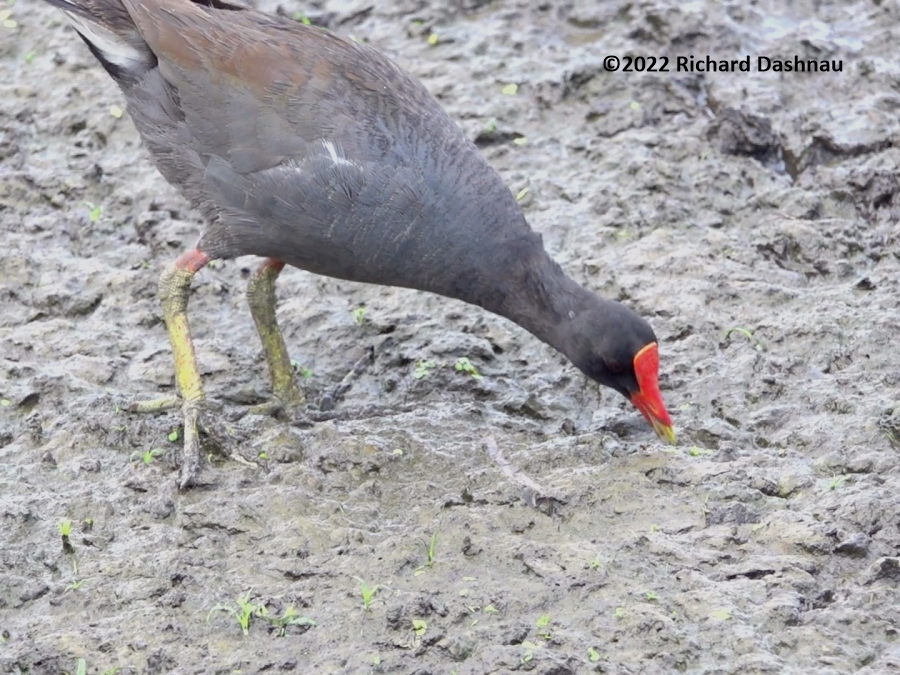
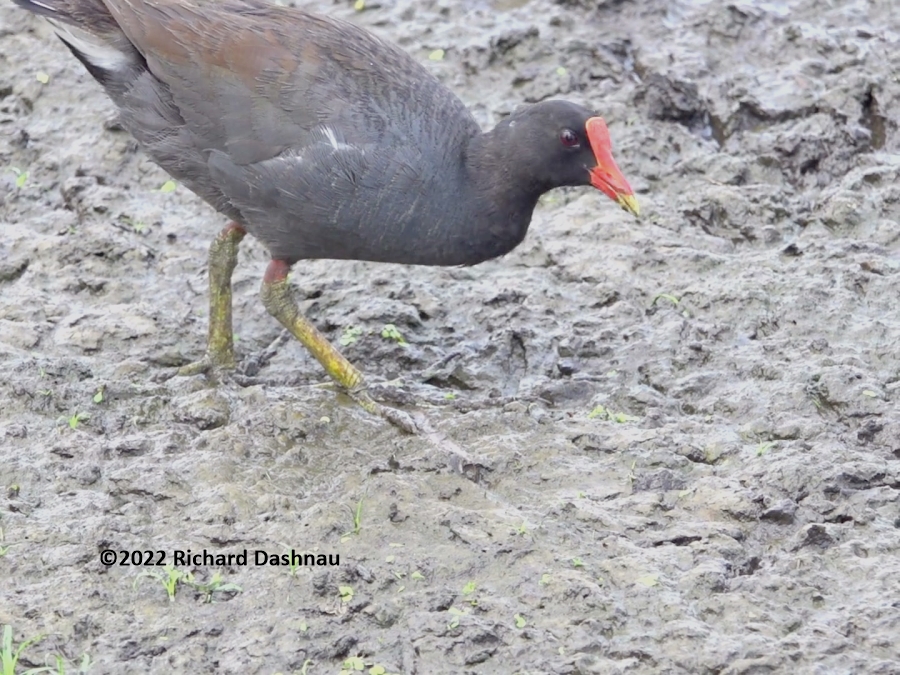
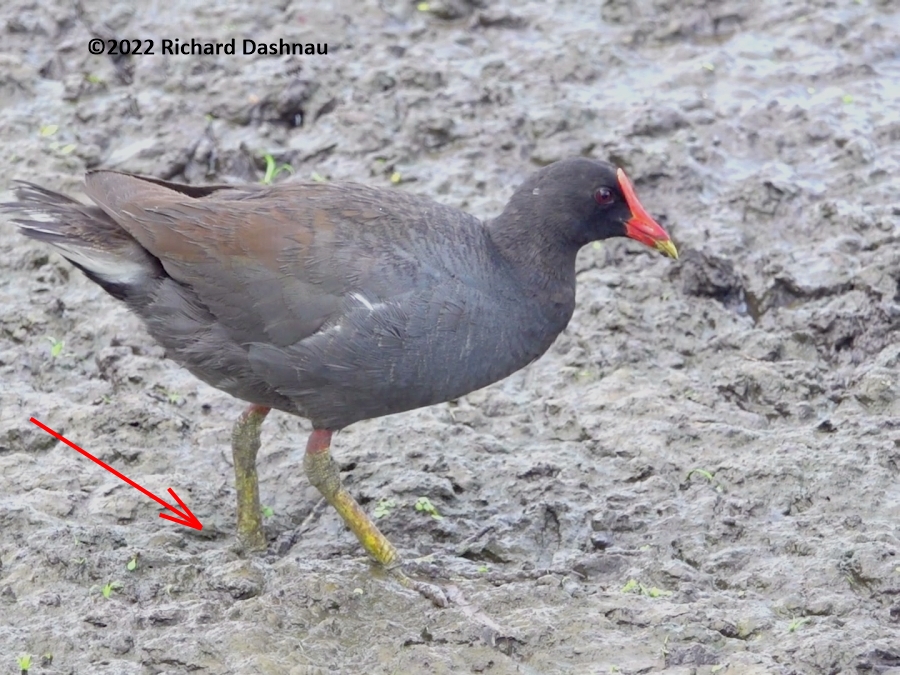
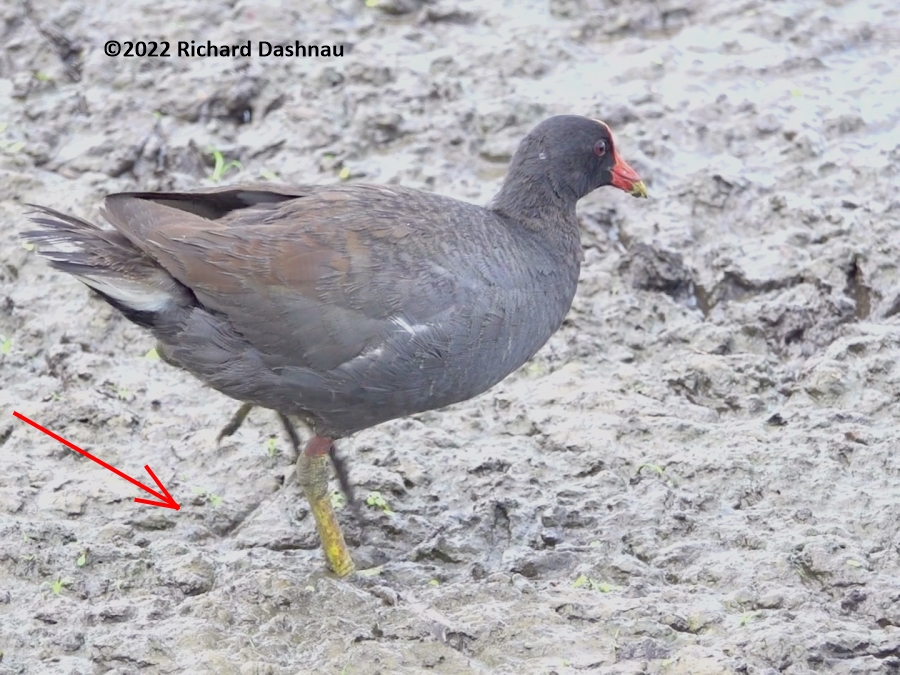
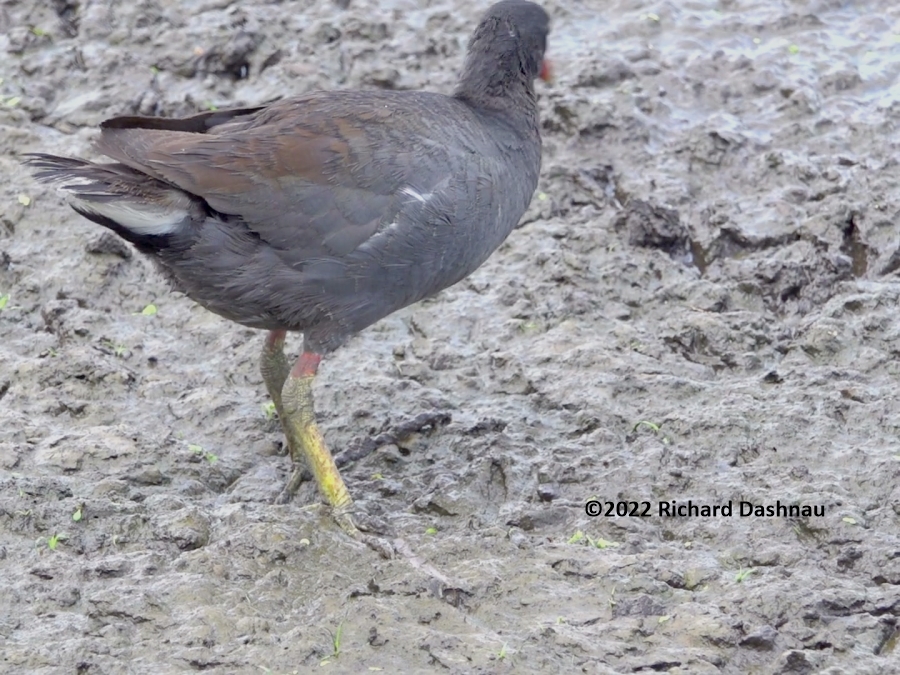
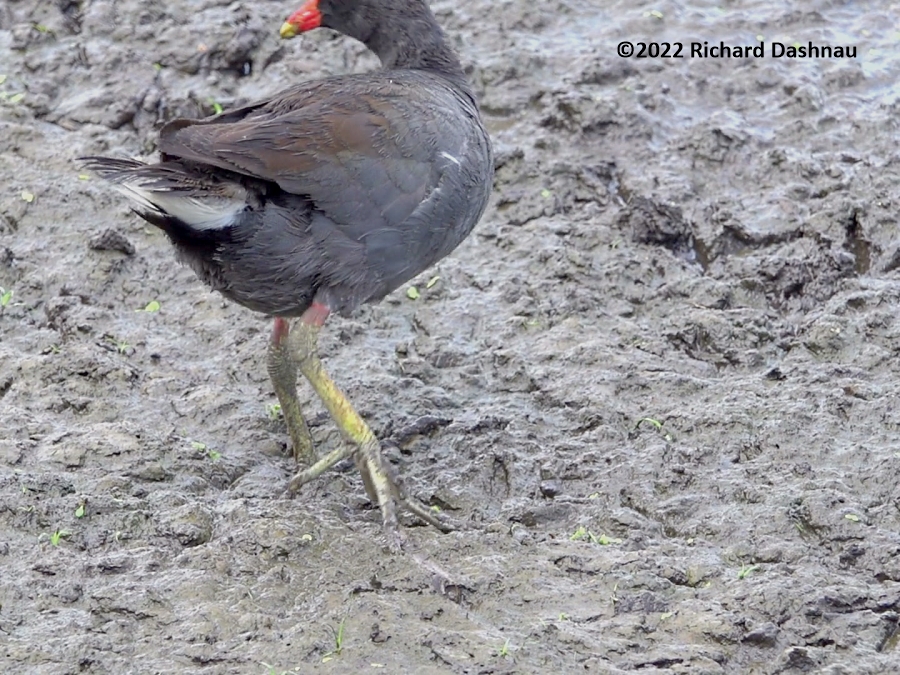
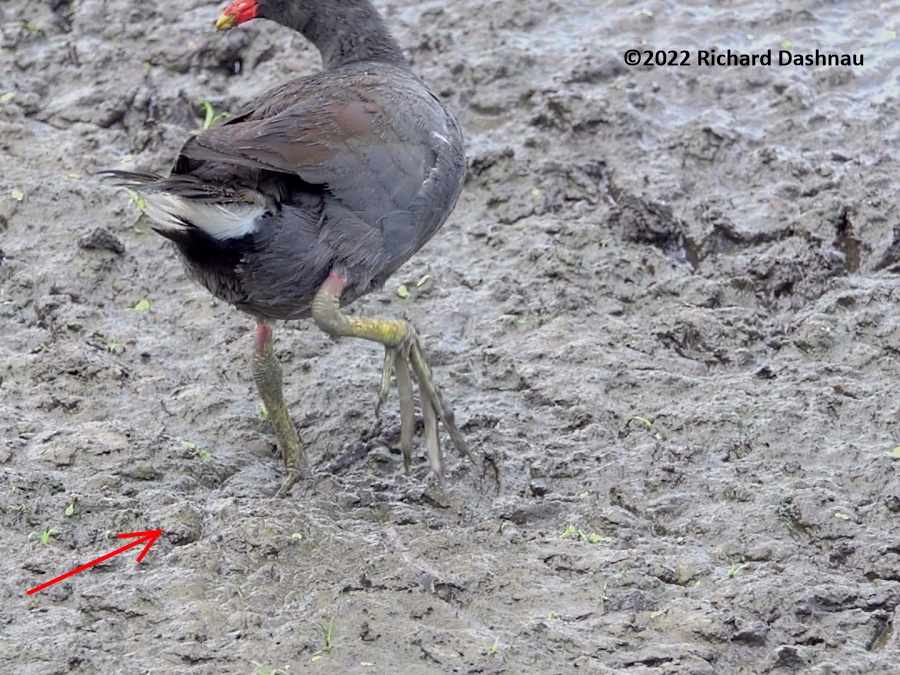
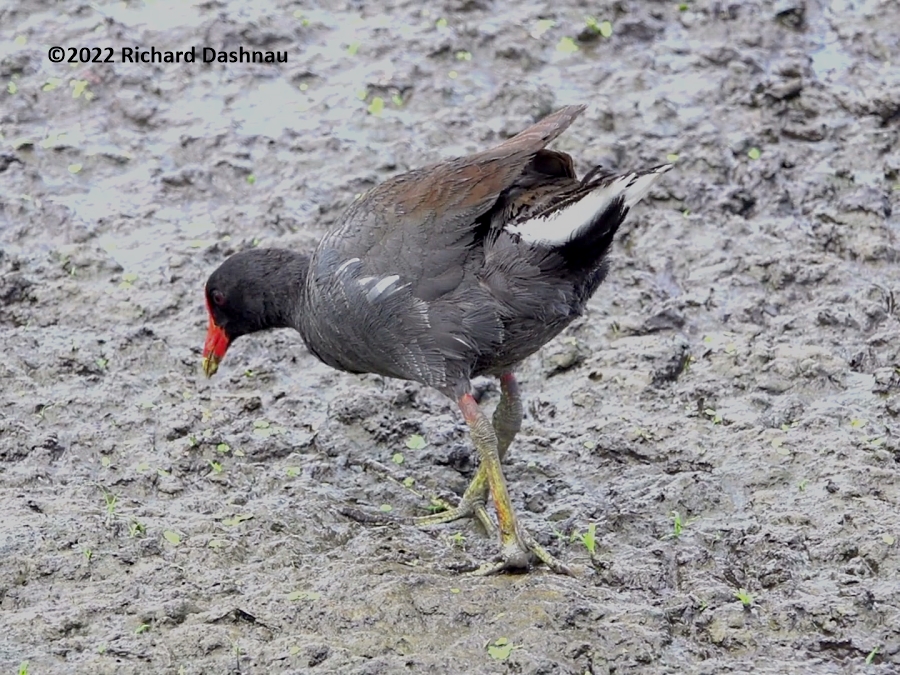


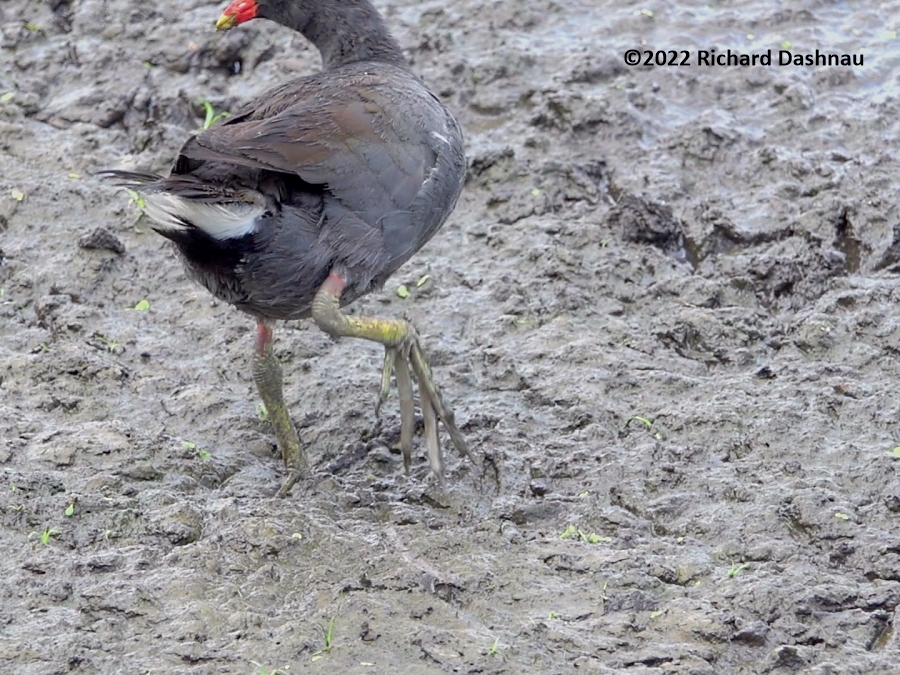

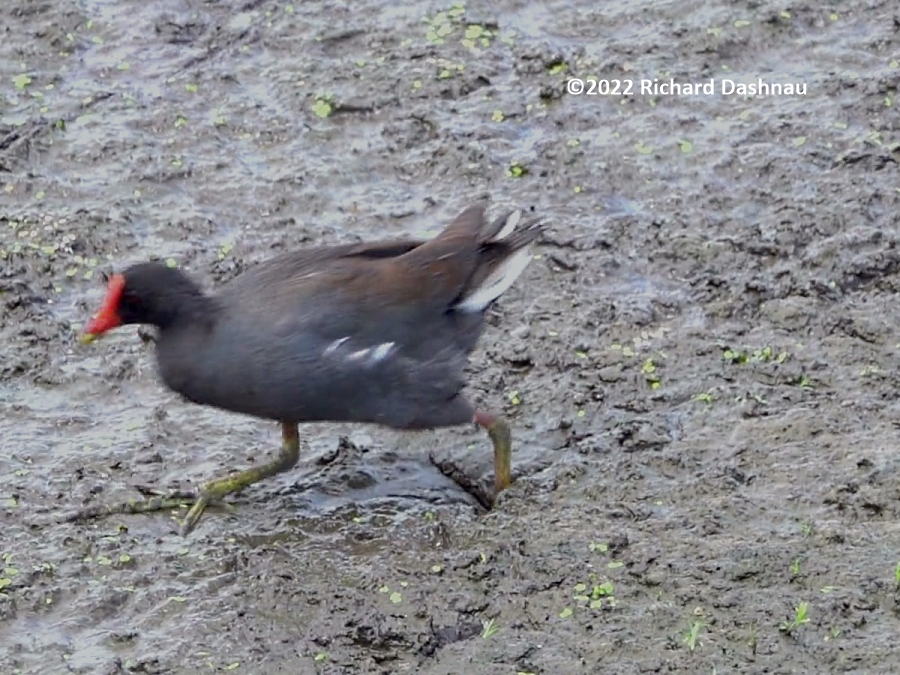
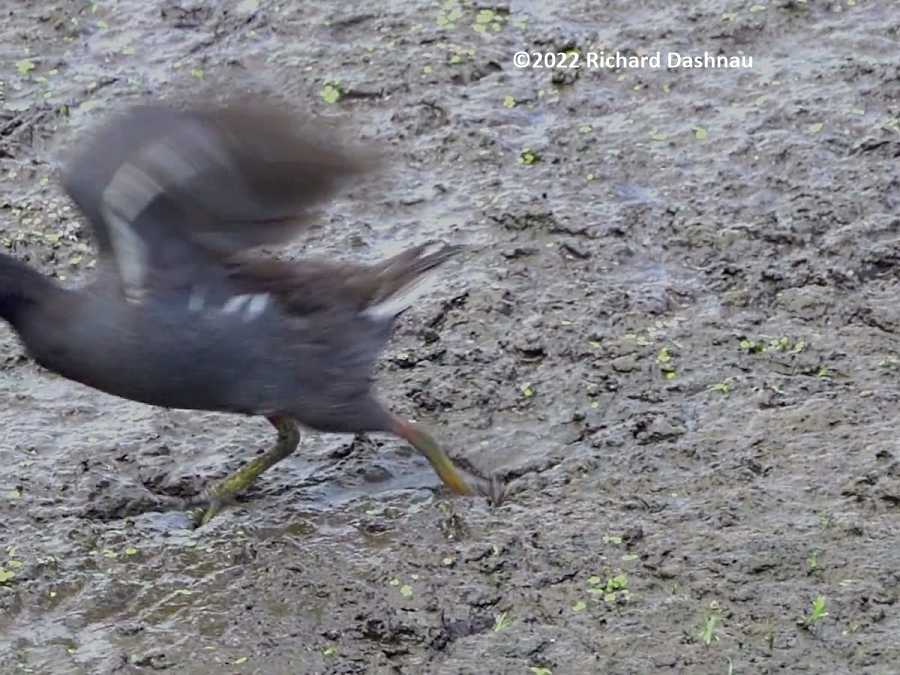
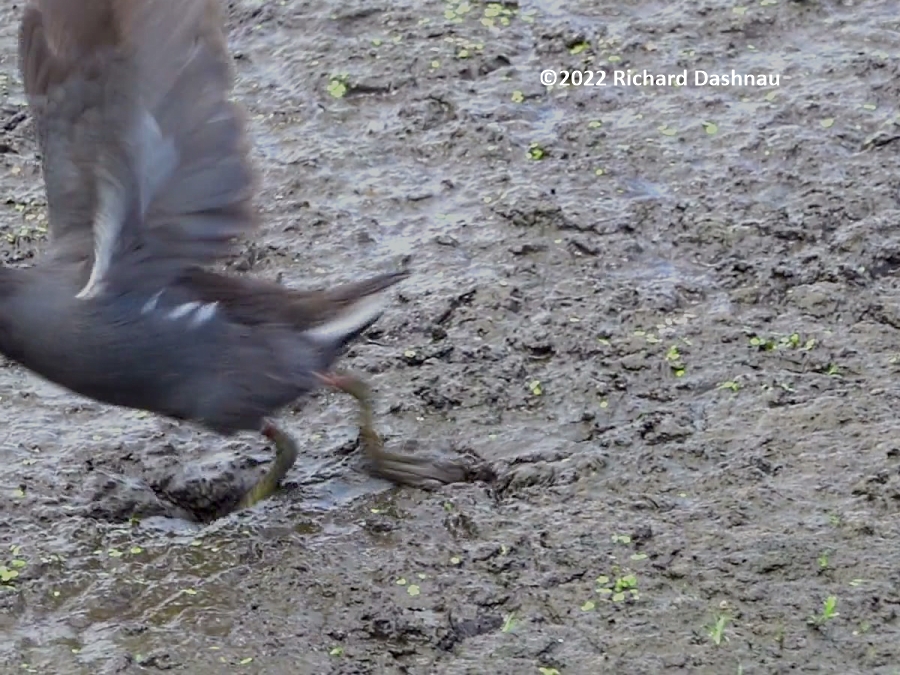
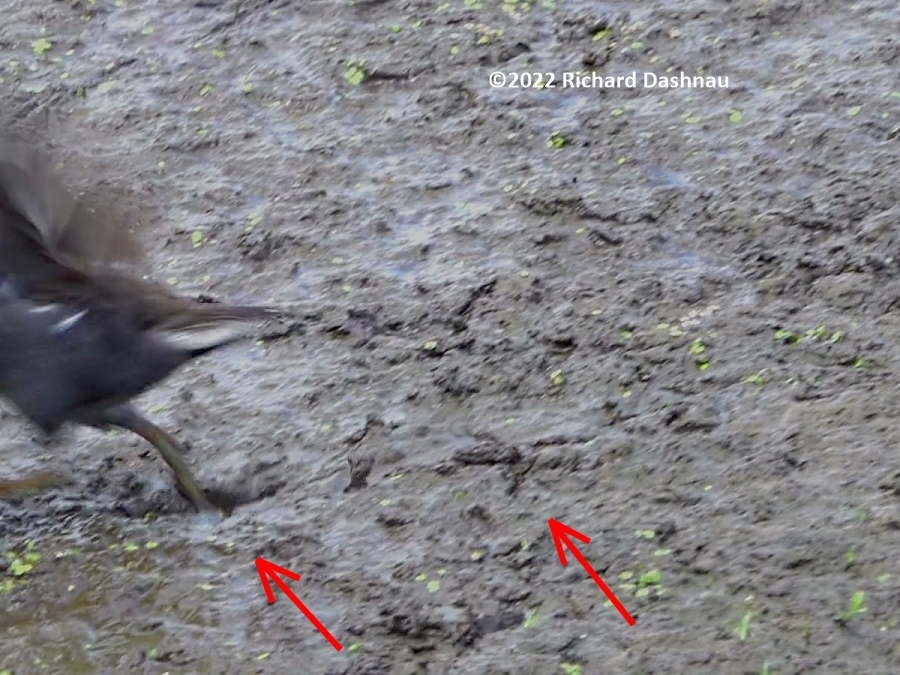
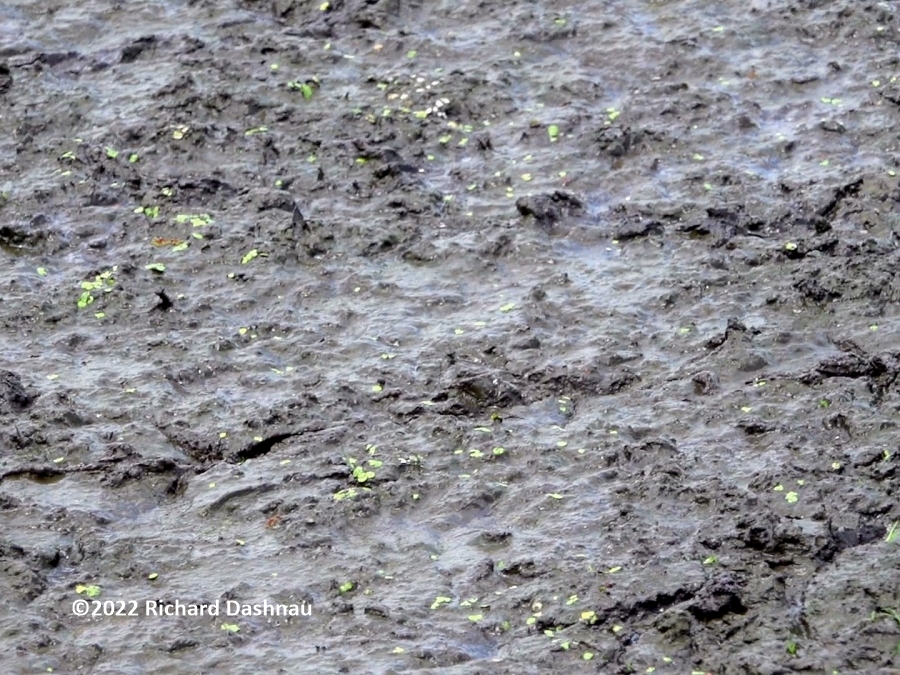
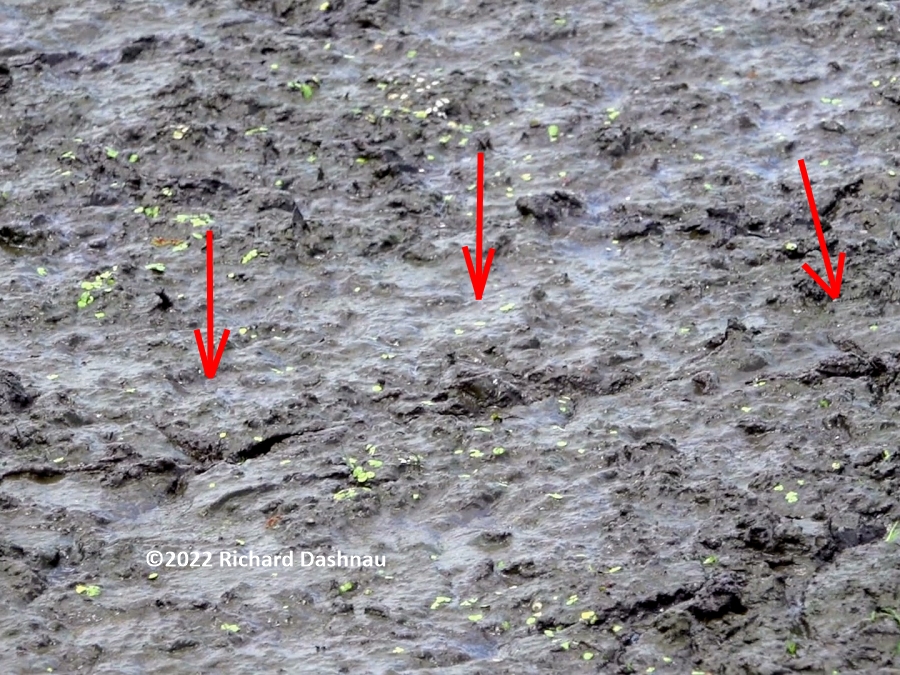
(added 2/21/2025) In
Houston on 05/18/2022
I'd seen Great-Tailed Grackles (Quiscalus mexicanus) hunting
cicada nymphs in this area, and had seen them digging into the
burrows by pulling up the caps. On this day, I shot some
video of a Grackle eating a nymph there, and that's shown on
this page. Afterwards, I shot very short video of a
Grackle
walking through the dirt. I tried to capture the formation of
footprints. The images below are frames from the video.
The arrows show the new footprints.
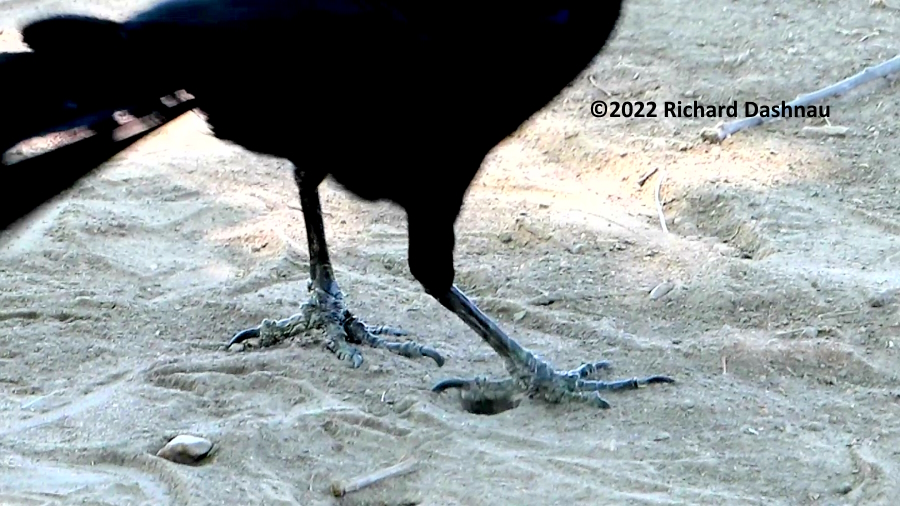
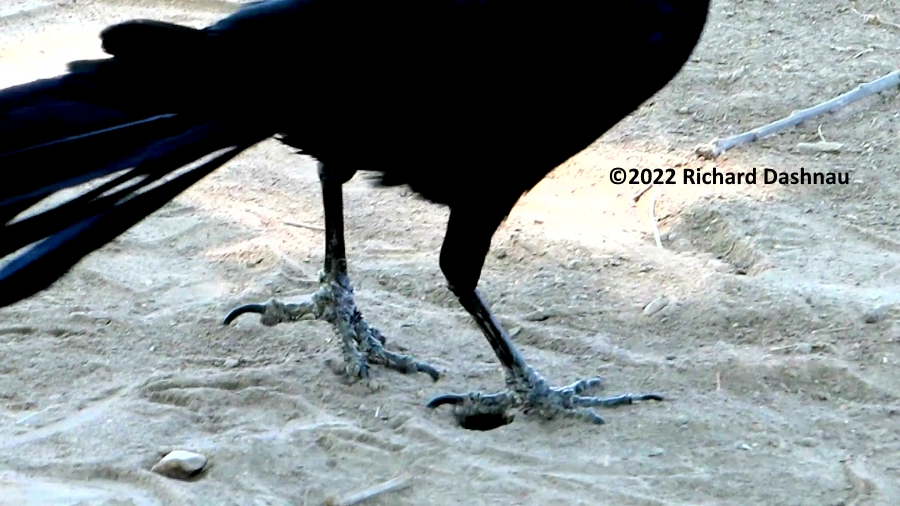
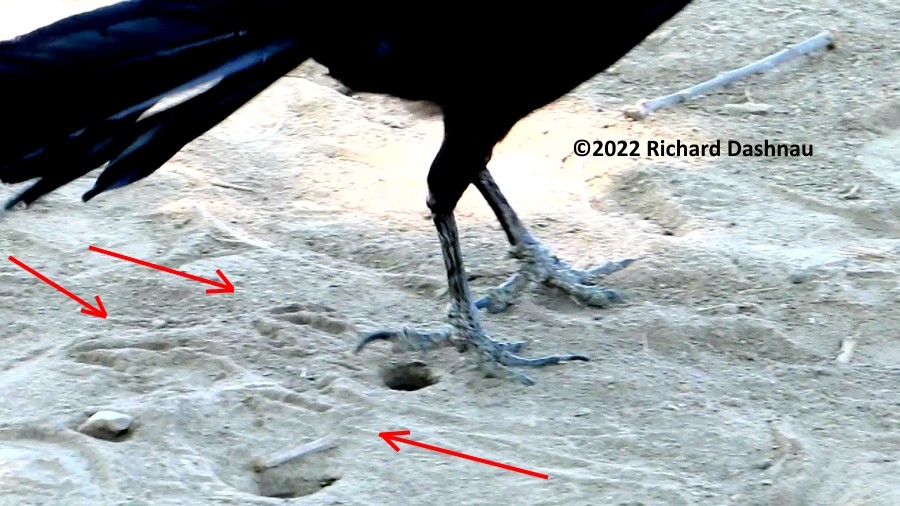
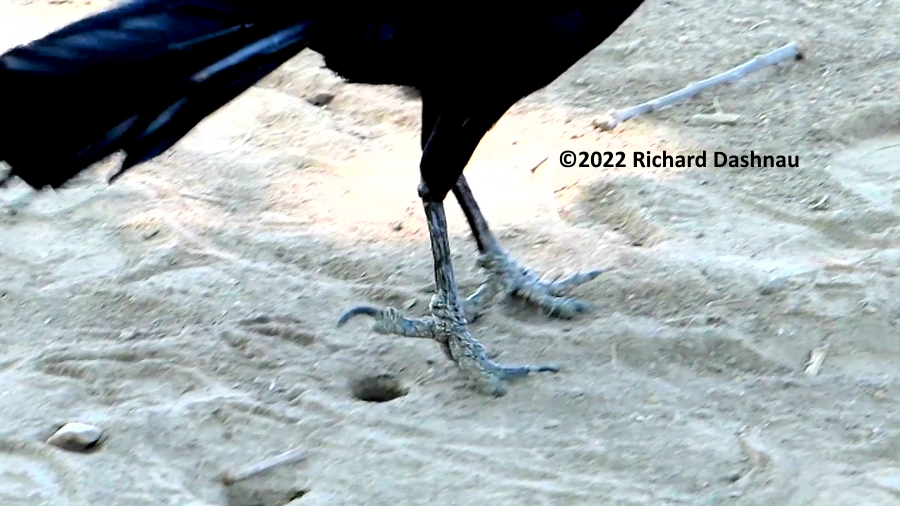
The Grackle walked past an old
burrow. Since the hole was intact, it showed the Nymph had
emerged a while ago, and had not been dug out by a predator.
The last image shows
more of the new traces, marked by arrows. The short video is here.
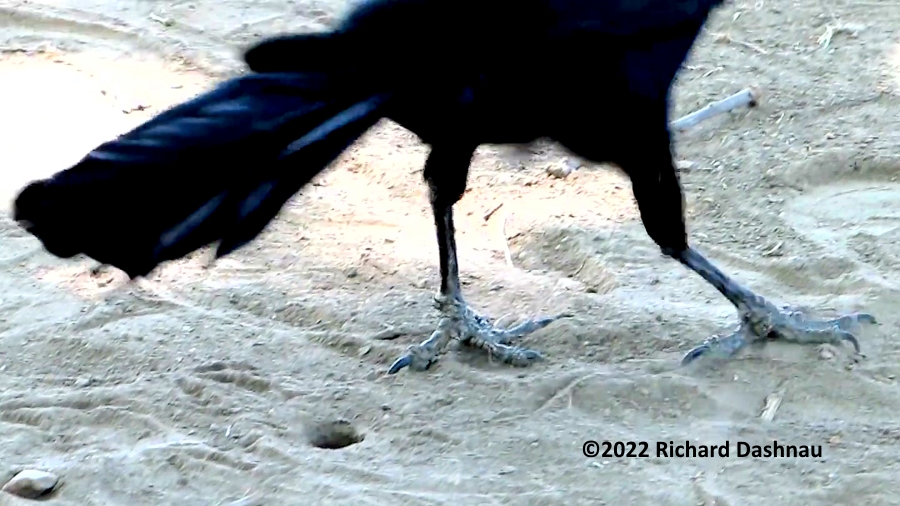
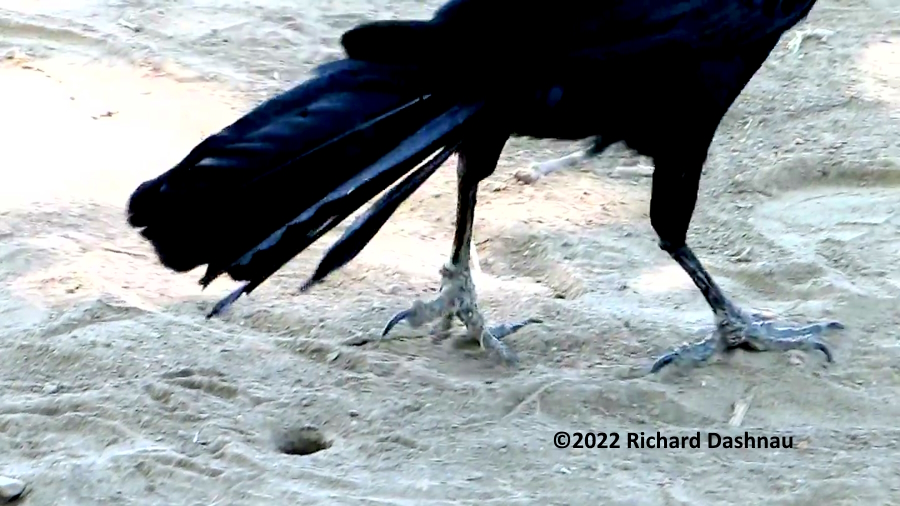
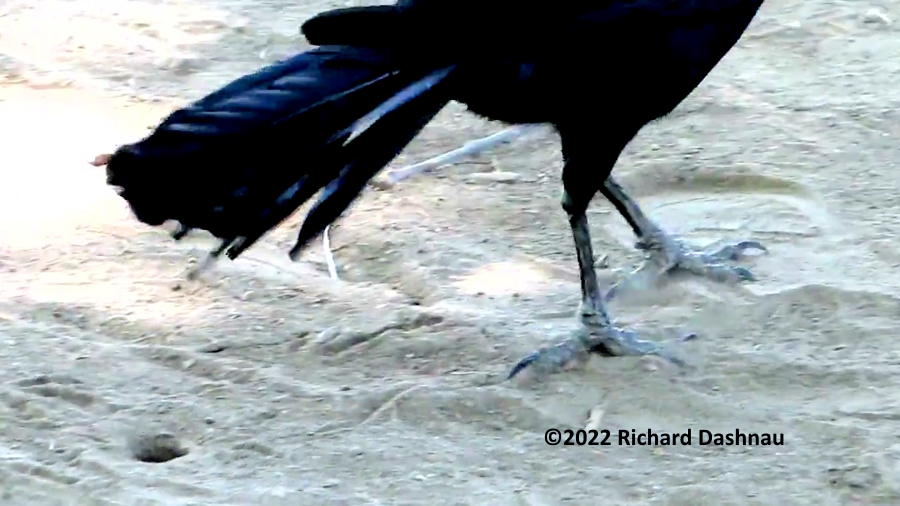
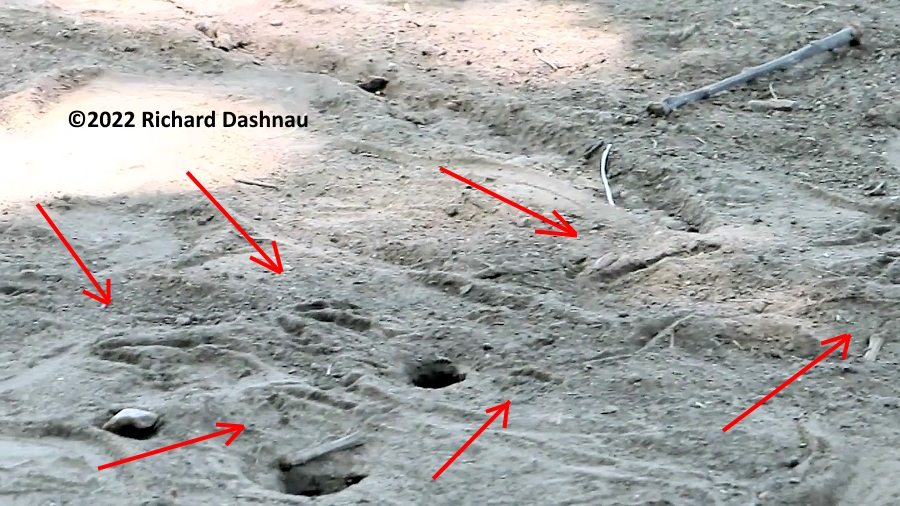
In Houston on 05/11/2022
At my exercise area, I noticed another mud "cast" on the dirt
trail. This time, I thought I knew what it was (because of
what I'd seen a week
ago), so I got the camera before investigating. I pulled
up on the "plug" and uncovered another cicada nymph burrow. Click
the
link for a short film that includes some of these photos
as well as some video clips.
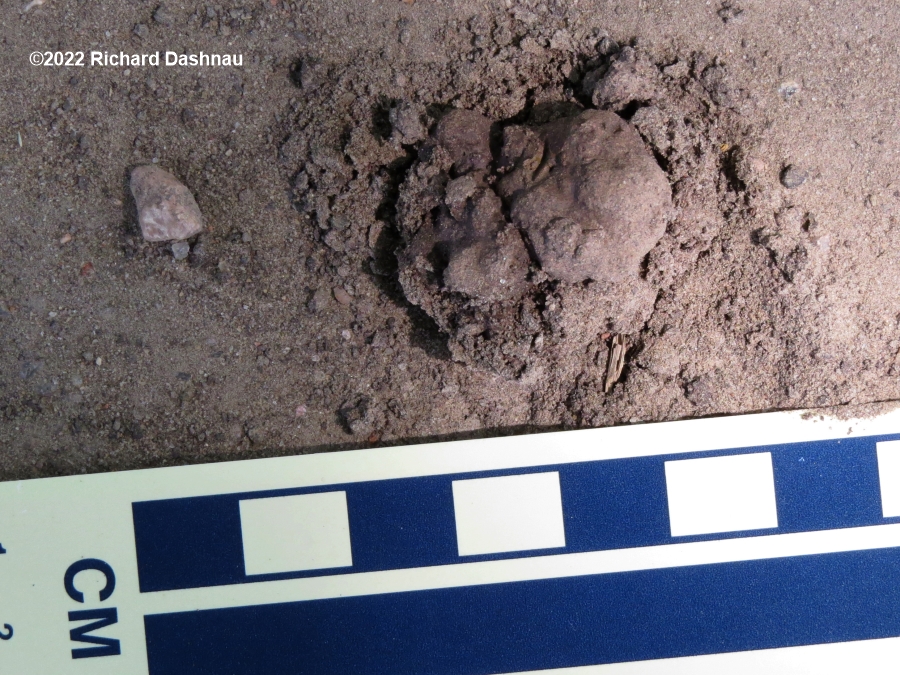
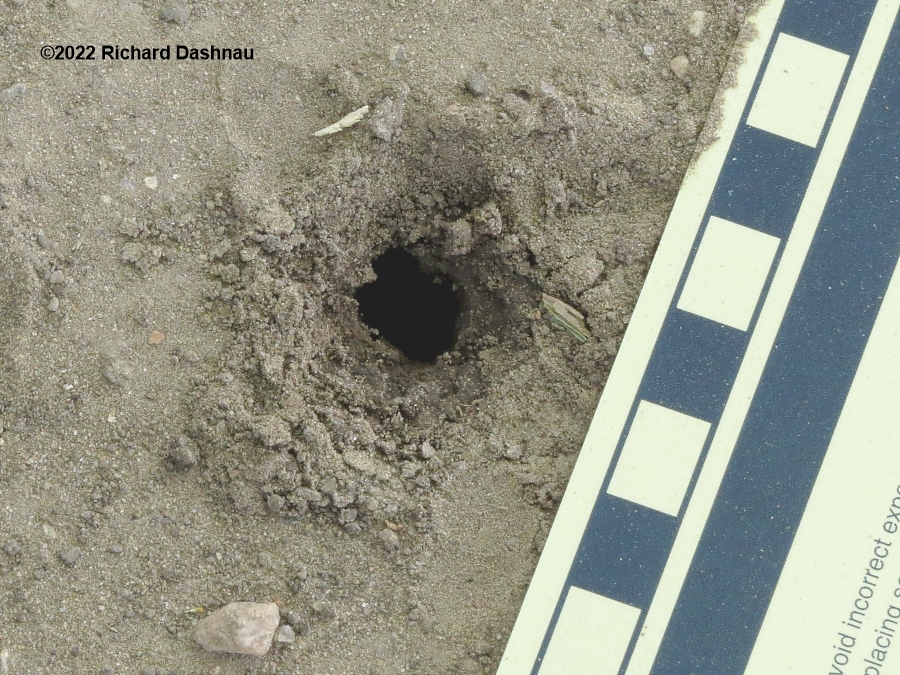
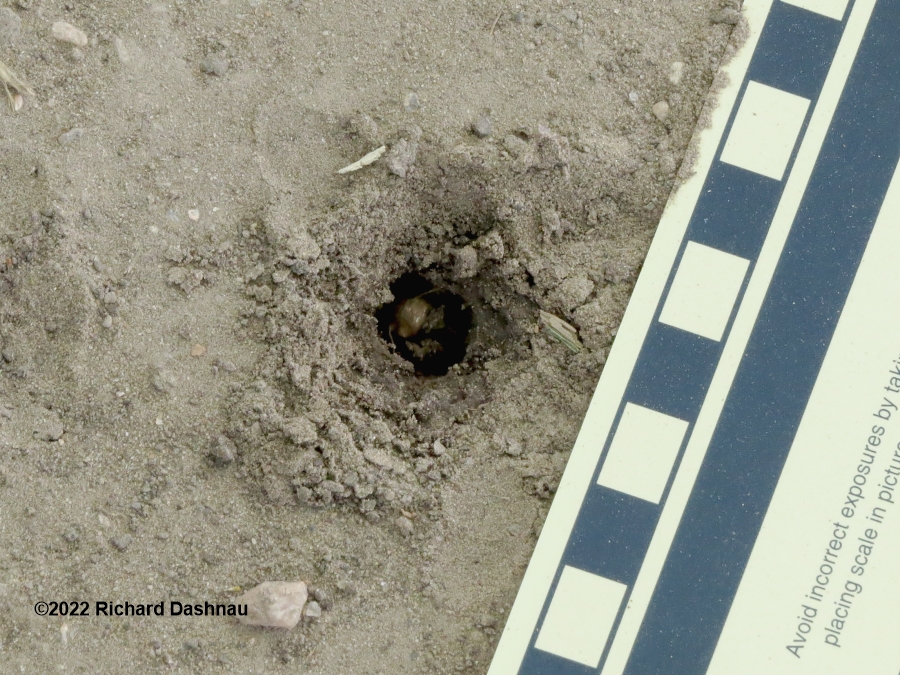
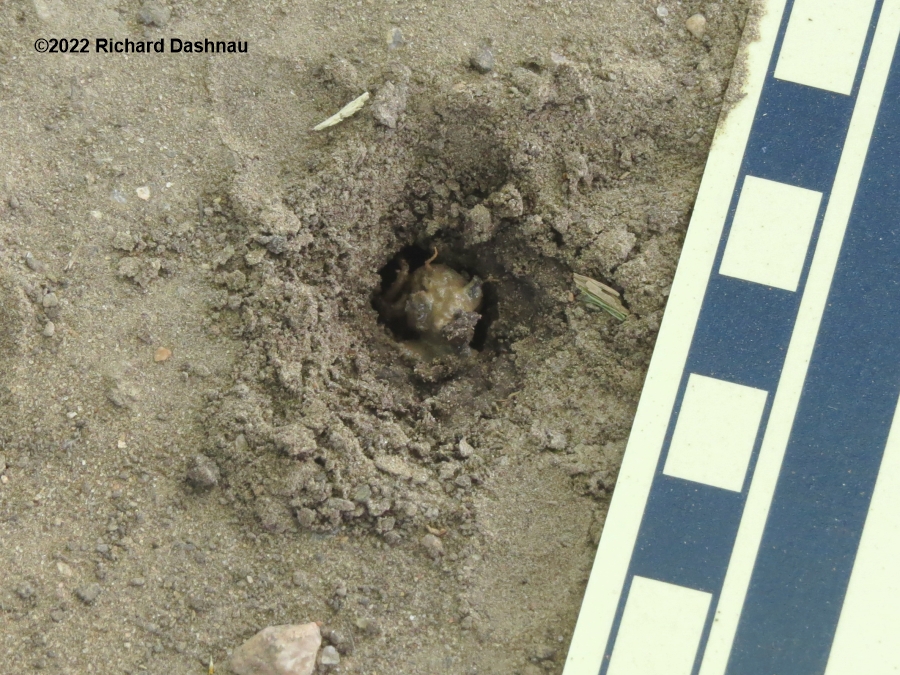
About 5 minutes later, a cicada
nymph showed its face, and started
applying a paste to the edges of its hole. As with the
previous nymph, this one withdrew, then returned a few minutes
later to add more paste to the edge of the hole. I replaced
the plug
and left something near it so I wouldn't step on it, and
started my exercises.
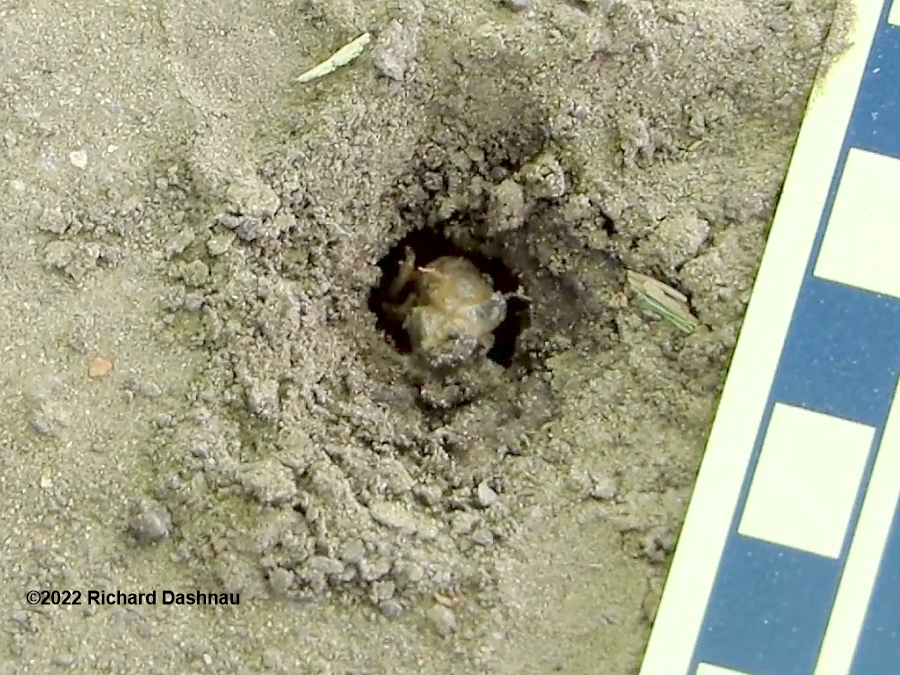
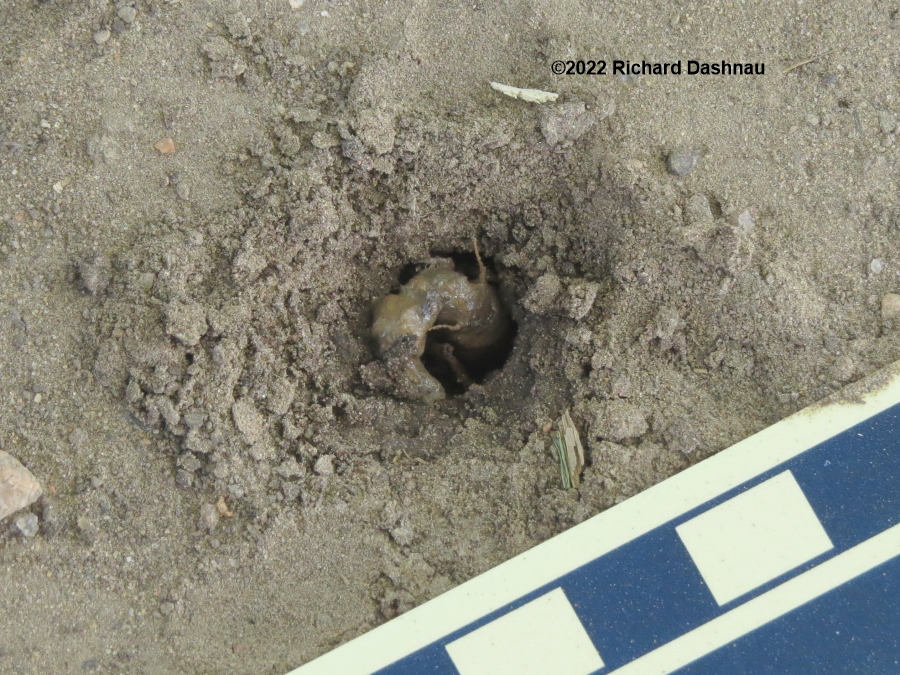
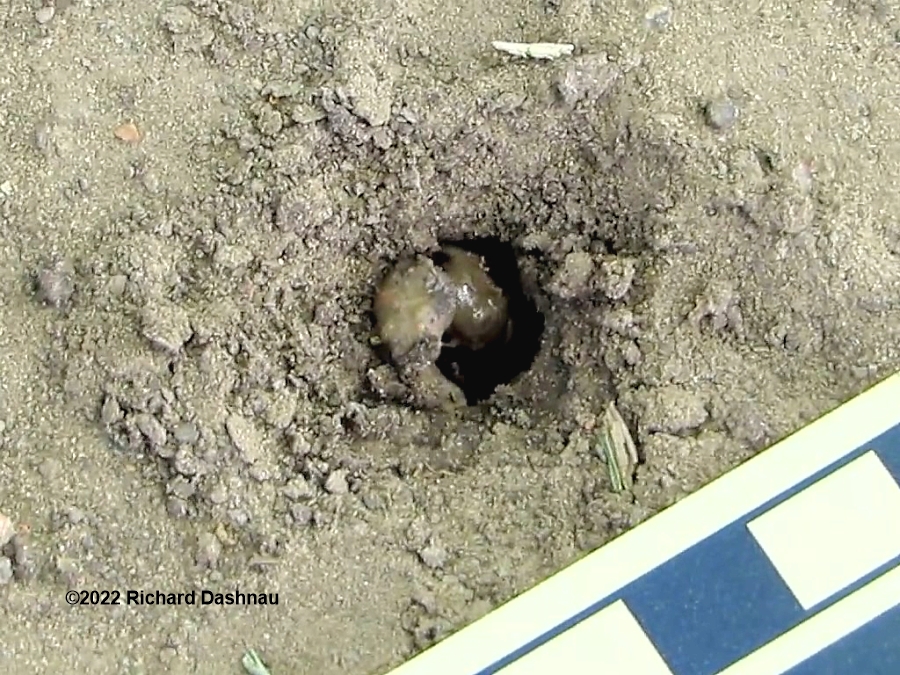
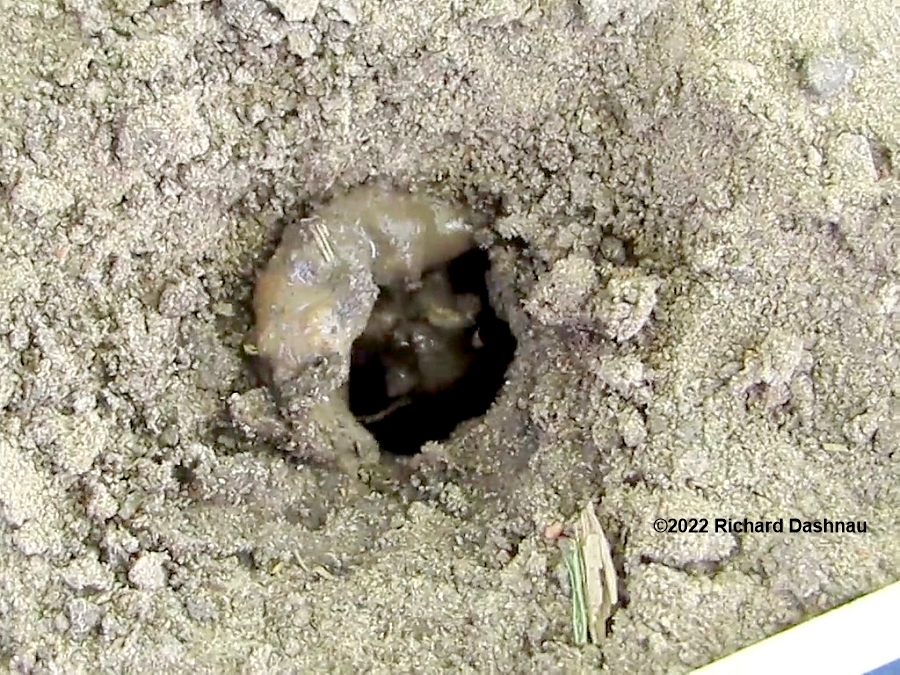
This is the second time I've
seen a cicada nymph produce "paste". I figure that it's
partially-composed of dirt; but what is the moistening agent?
The ground was dry, and I don't think there
was "mud" just a few inches down. Do the nymphs secrete
liquid? If they do, what is it--water, mucus...something
else? How much can a nymph produce?
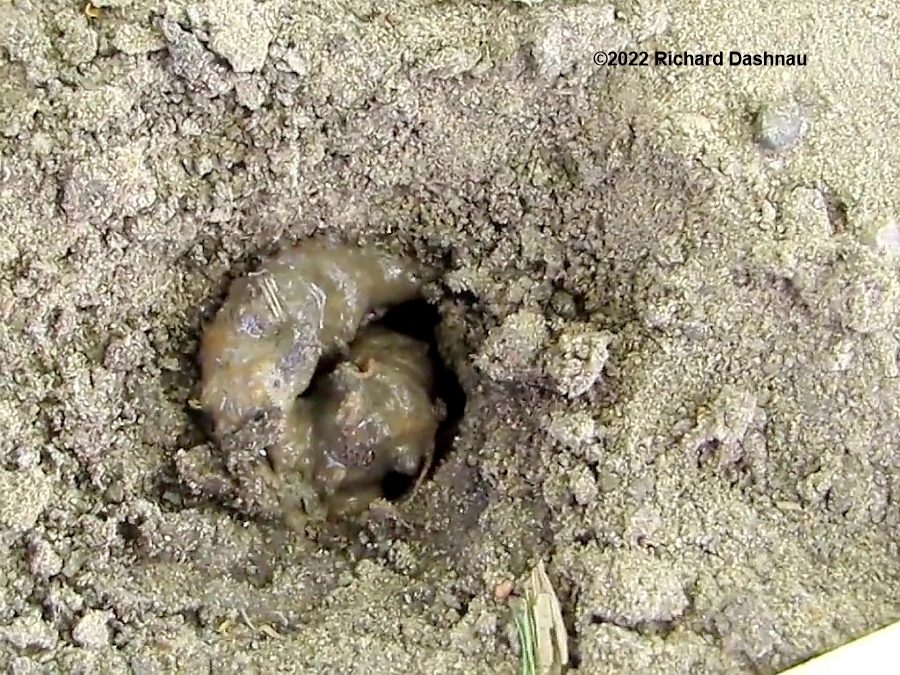
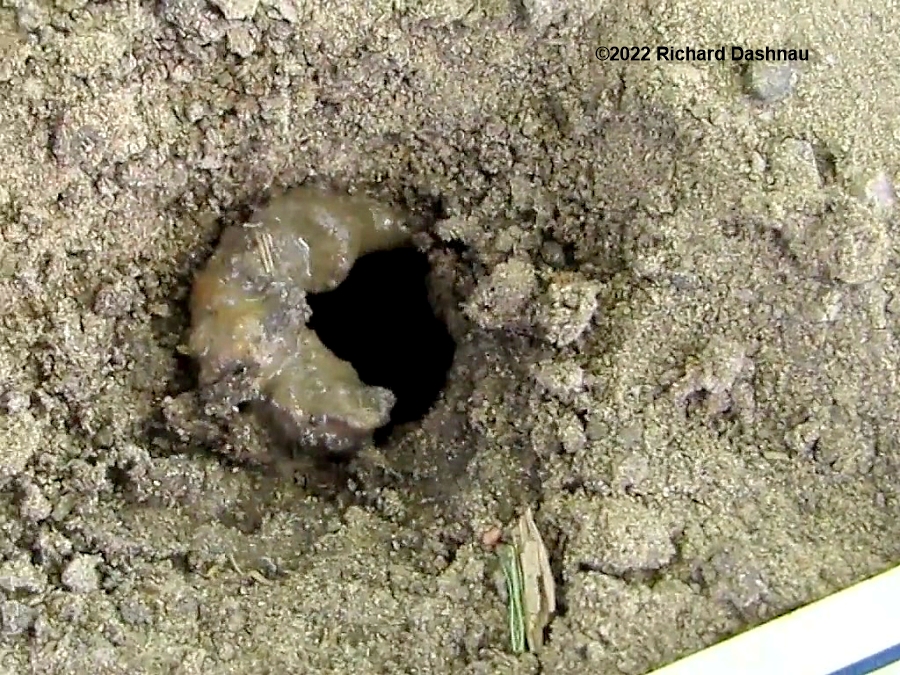
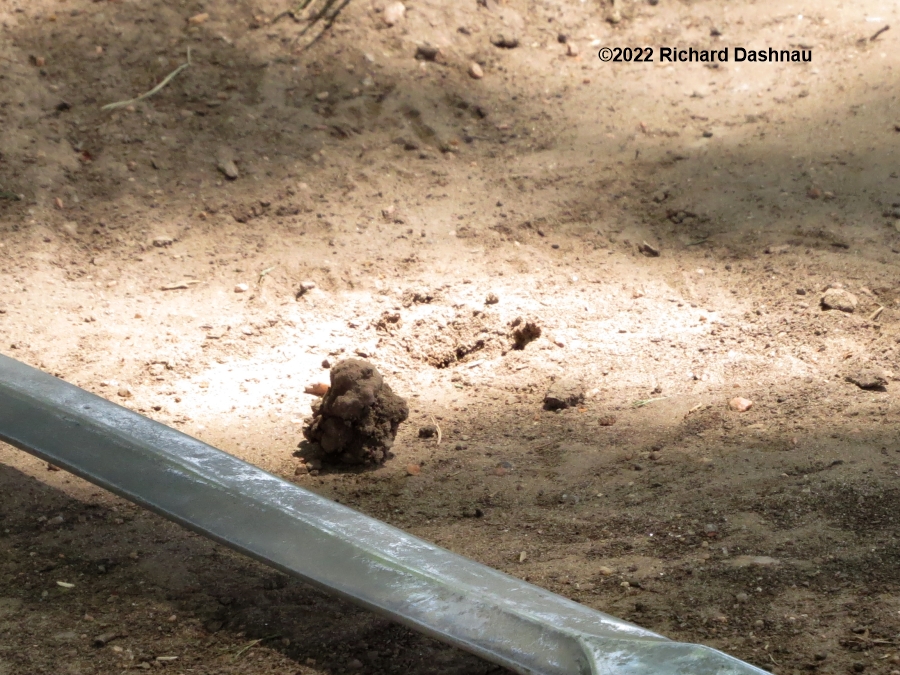
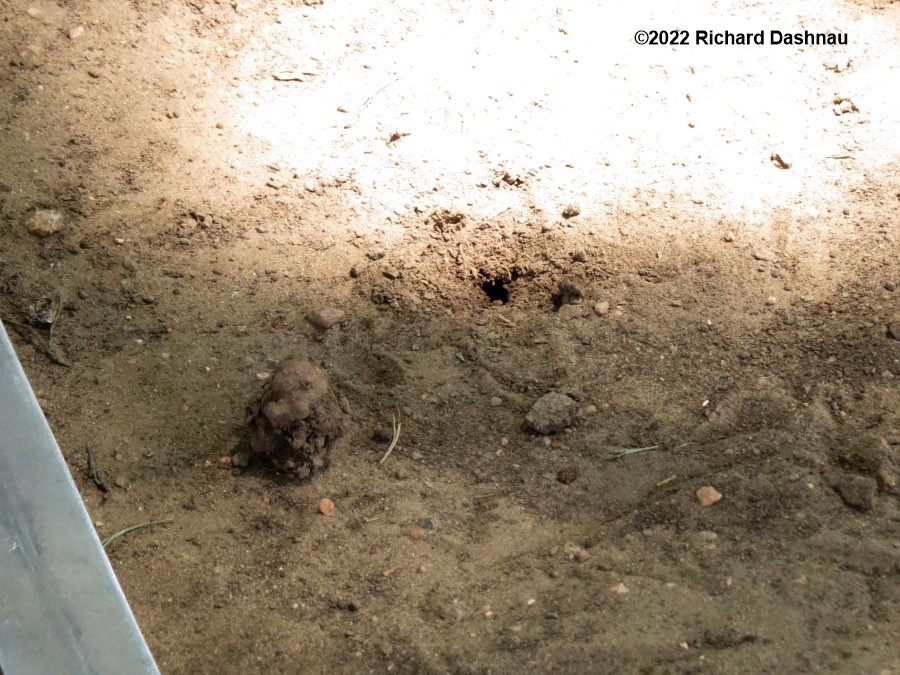
From
Houston on 05/02/2022.
I was checking my exercise area for stones and poop when I
noticed this lump. I didn't want to step on it for many
reasons. I could
already tell that it wasn't poop, but thought it was a
burrow casting of some kind. When I picked up the lump,
what I uncovered was so interesting that I put lump back, then
delayed my
exercise to run back to the car and get a camera. Then I
lifted the mud lump again. The hole looked like a cicada
burrow (I often see them here). But the fabricated mud cap had
confused me...
...until the owner of the
burrow appeared.
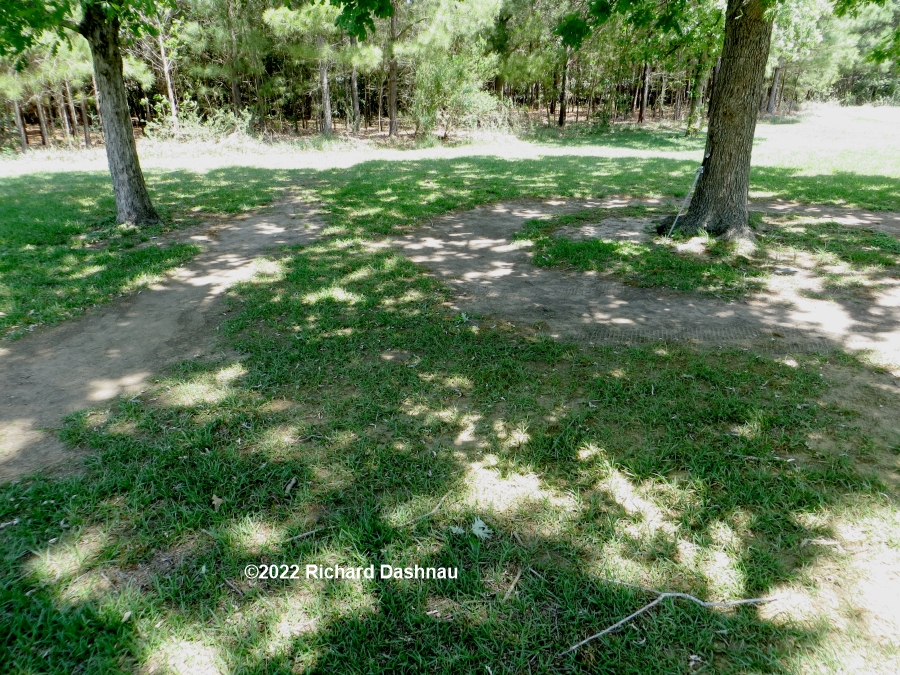
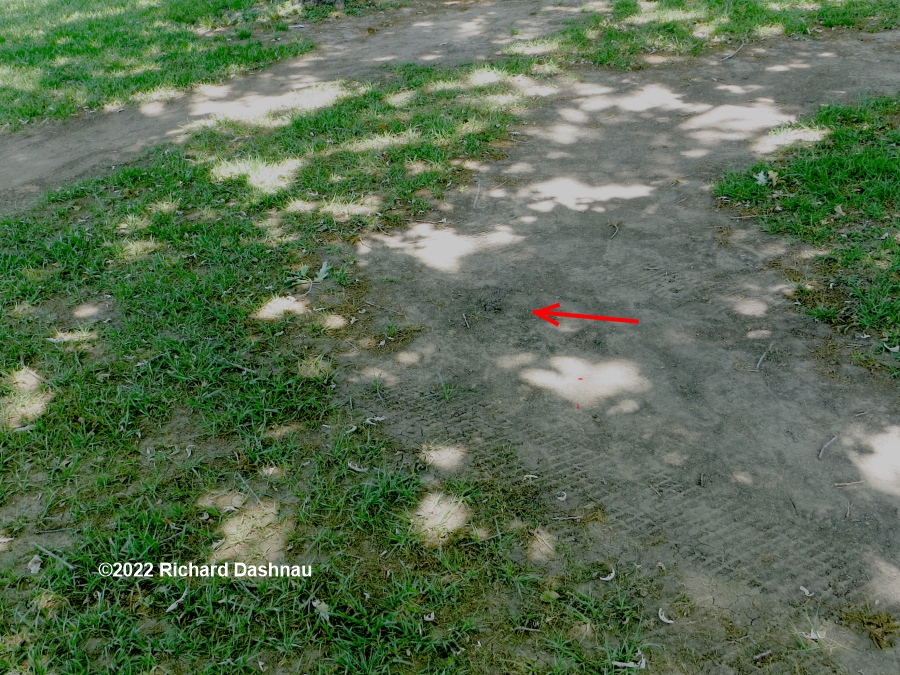
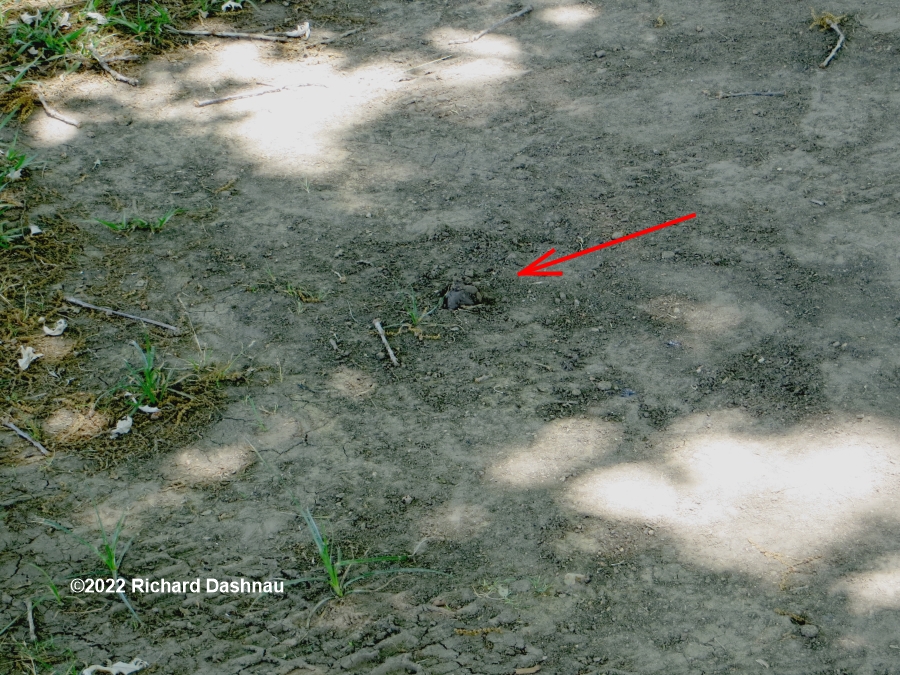
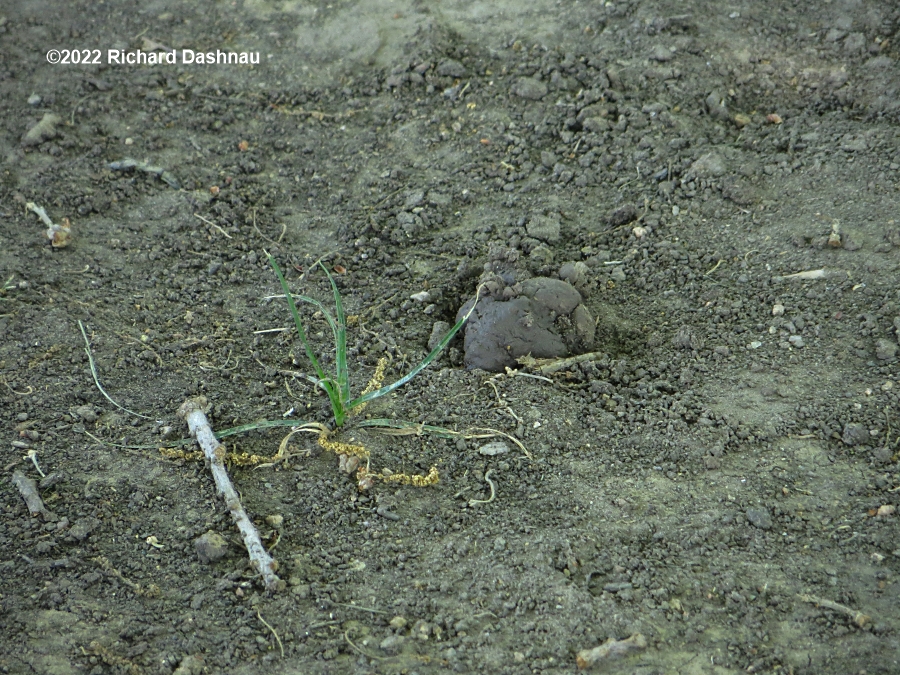
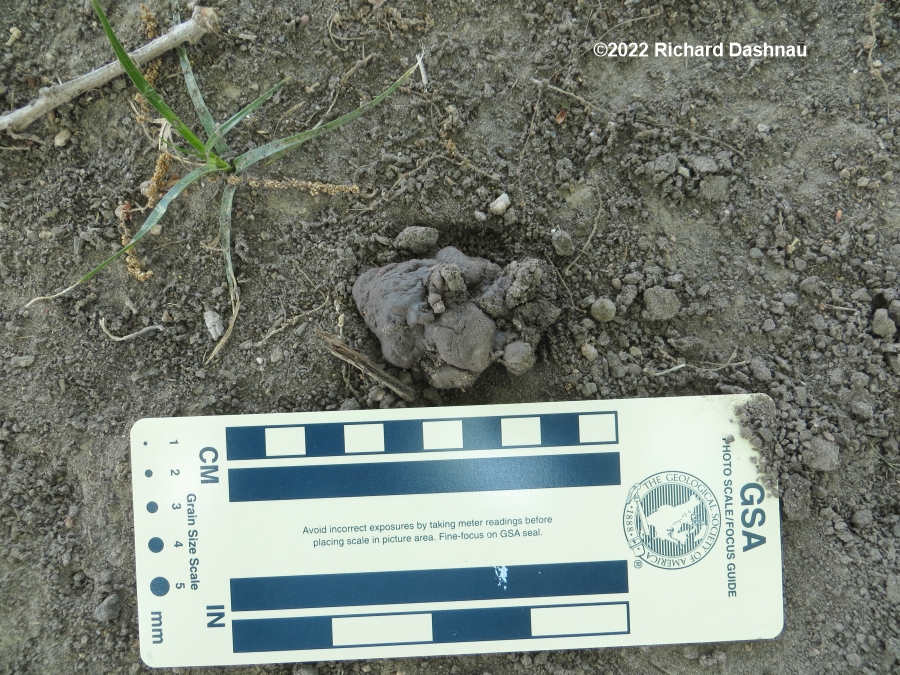
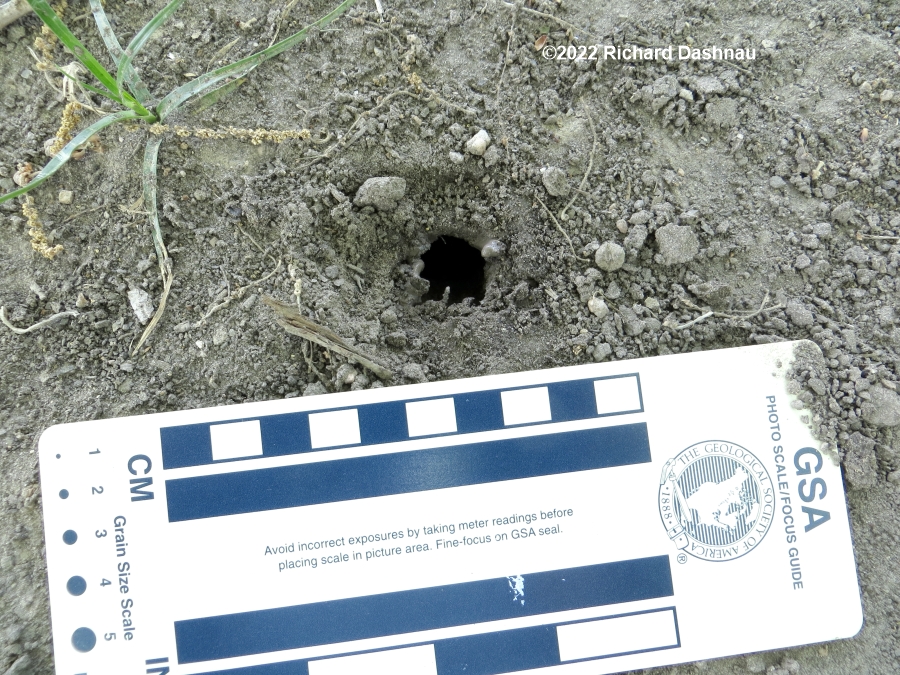
It was a cicada nymph! Then it returned to the depths.
By the way, the images of the nymph below are from video
I filmed then. You
can see the
short video here (mp4).
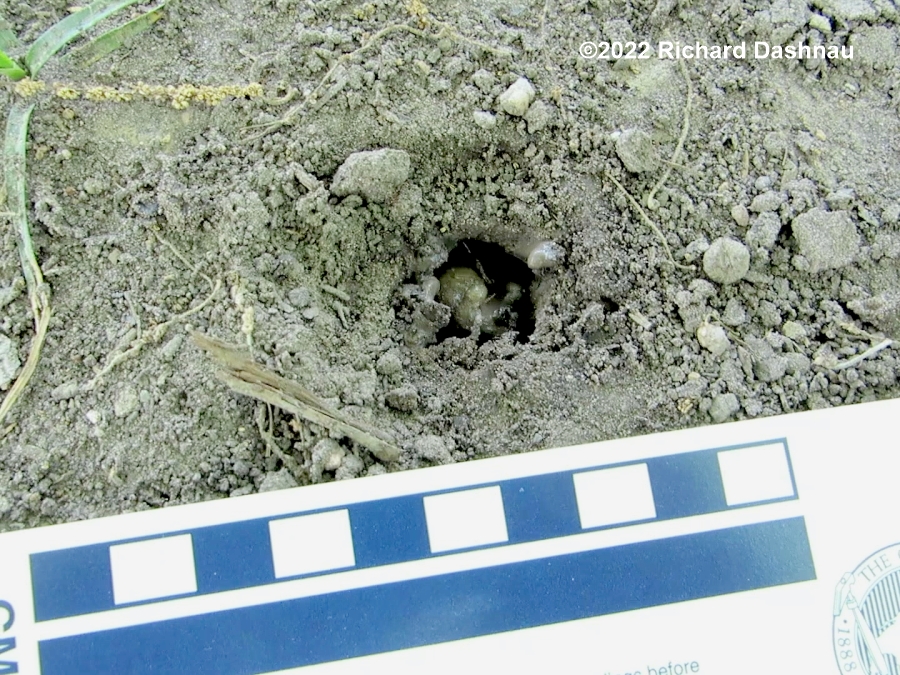
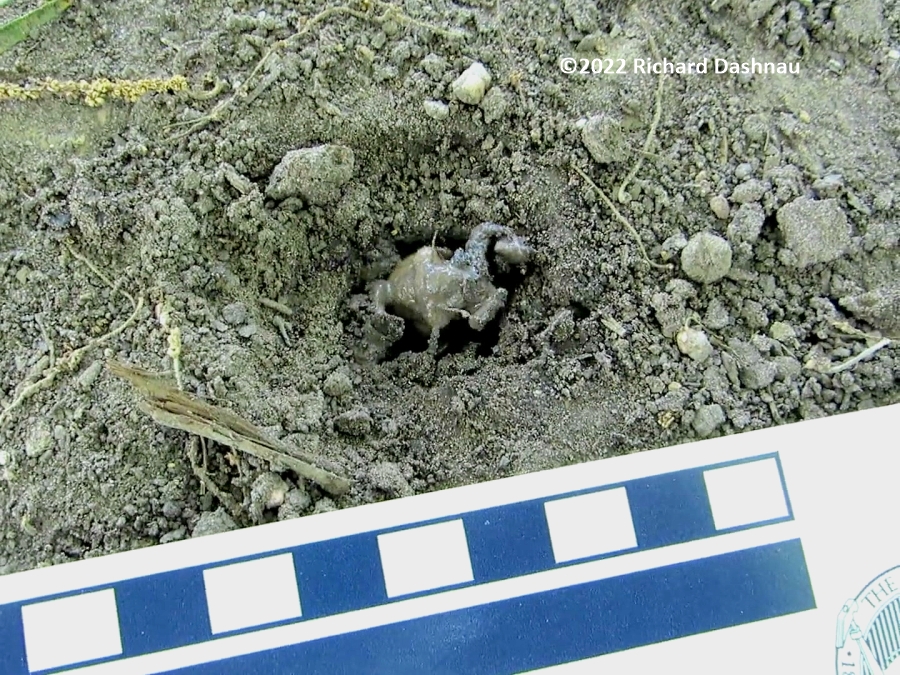
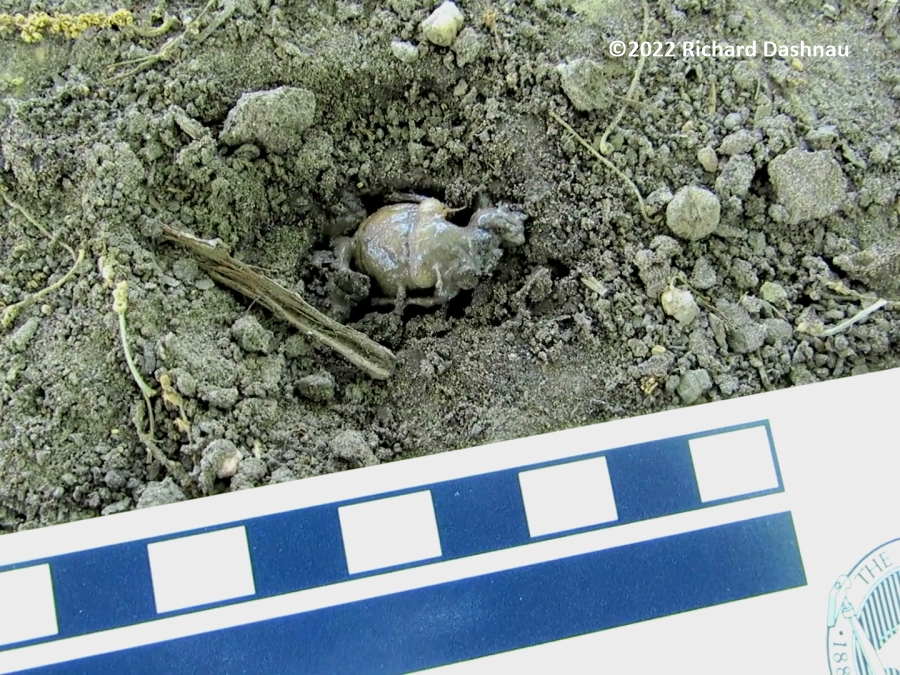
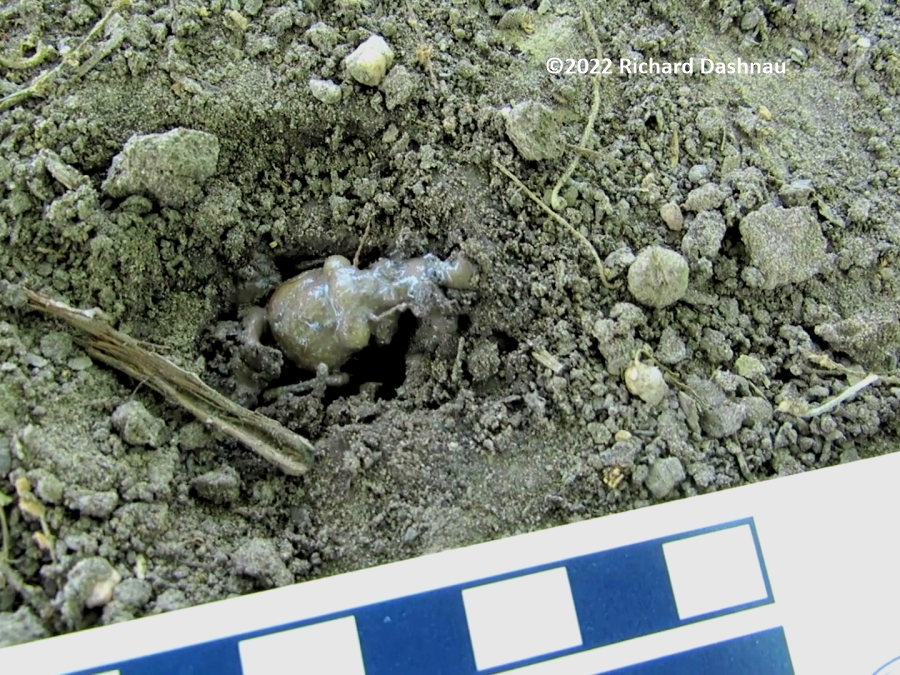
I waited a while, and it made
another trip. I've seen many cicada burrows-here, and at
other places. But this behavior was new to me, so I did
research after I got back home. Cicada
nymphs sometimes make a chimney, turret or a cap
over their burrow while waiting to emerge! I saw
pictures online of some turrets that resembled small versions
of crawfish chimneys.
Type "cicada chimneys" or "cicada turrets" into your favorite
image search and you'll see what I mean. This really
surprised me. I'd just assumed that the nymphs came out of the
ground
when they are ready to do their final molt, climbed up, and
did their final "pop". But apparently sometimes they "wake up
early", hit a snooze button and go back underground for a
while.
I was also reminded by many references to how Copperheads like
to hunt for emerging cicadas--and possible increase in numbers
of Copperheads during Cicada emergent times.
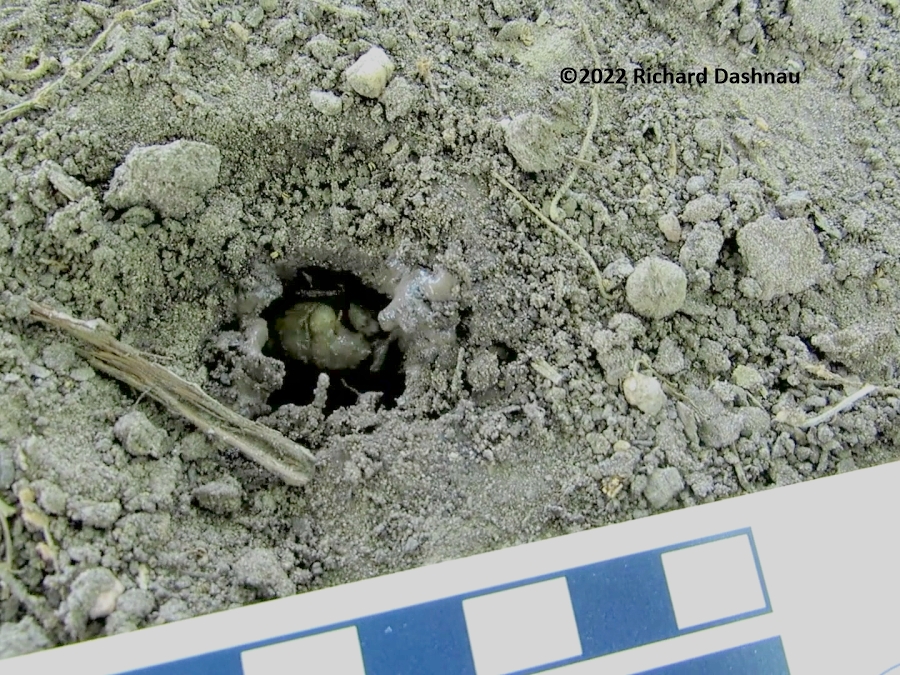
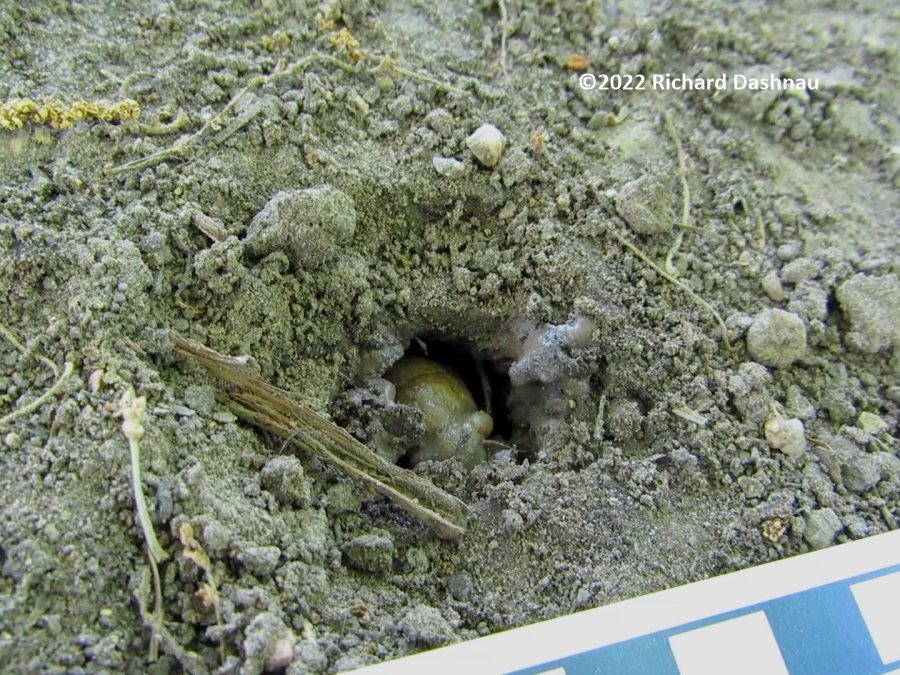
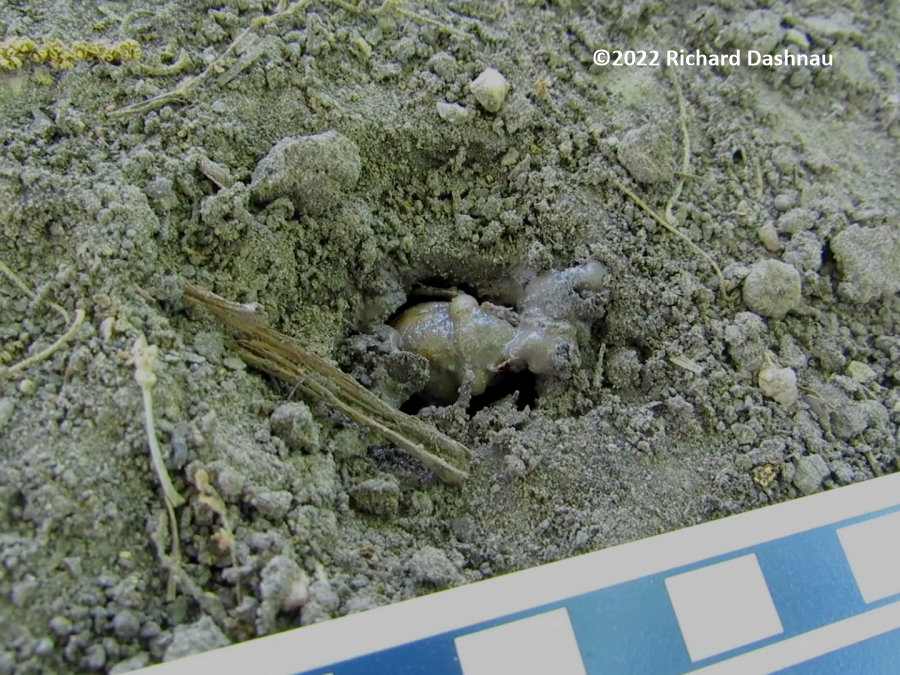
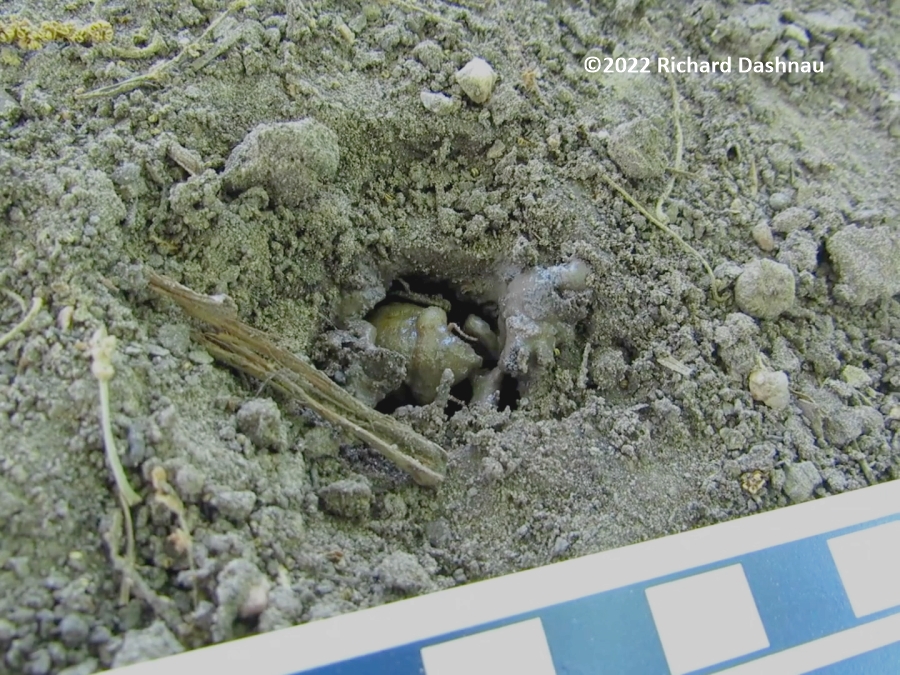
This is the underside of the cap that I removed. It was hollow
on the bottom. I put the cap back over the hole. Note how
dry the dirt is--the cap had not been"glued" to the loose dirt
.
I put my tripod over the hole so I wouldn't disturb it
further when I resumed my exercises.
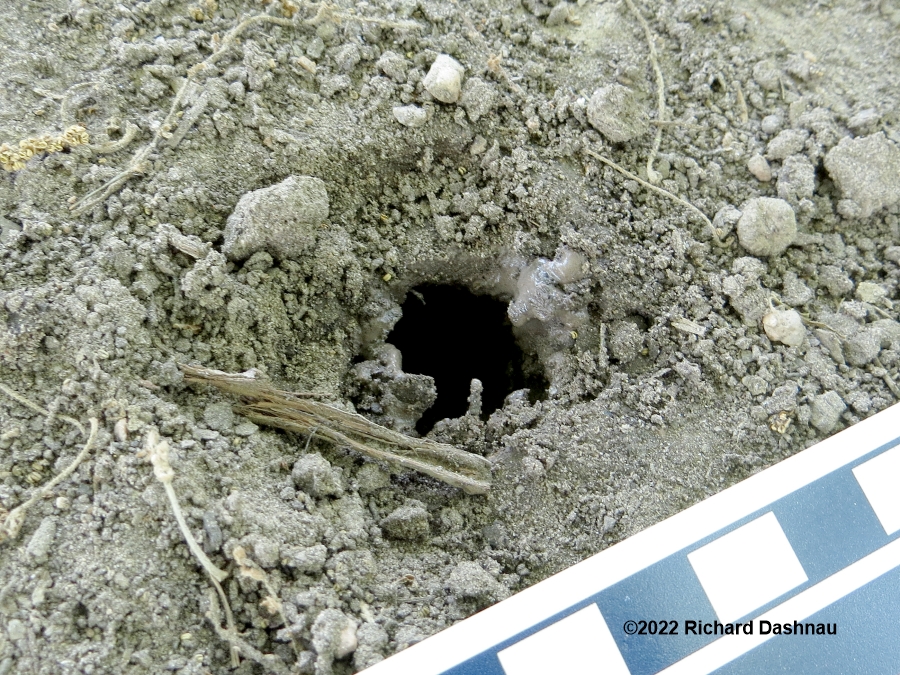
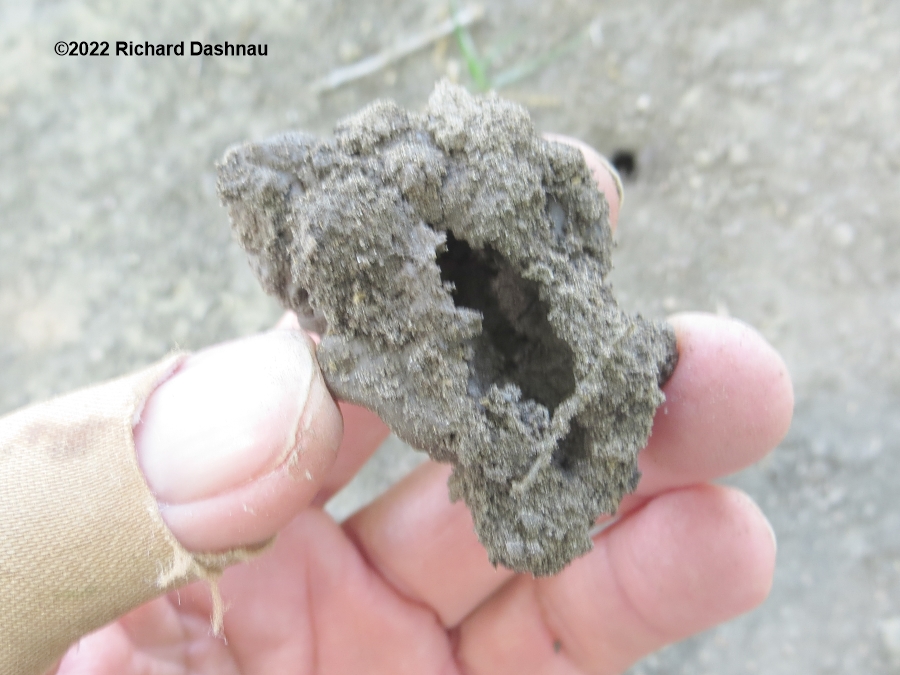
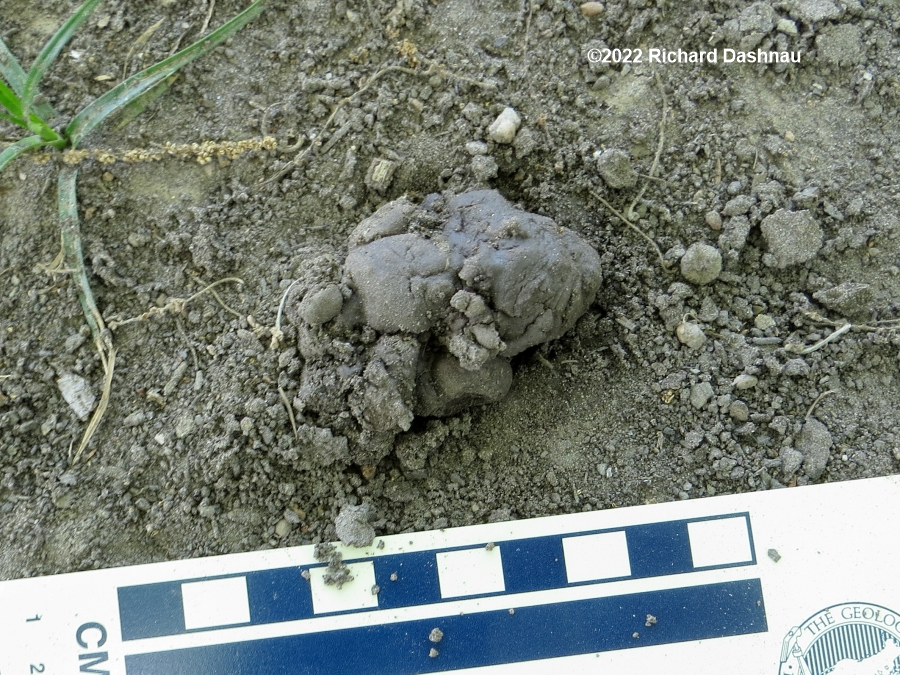
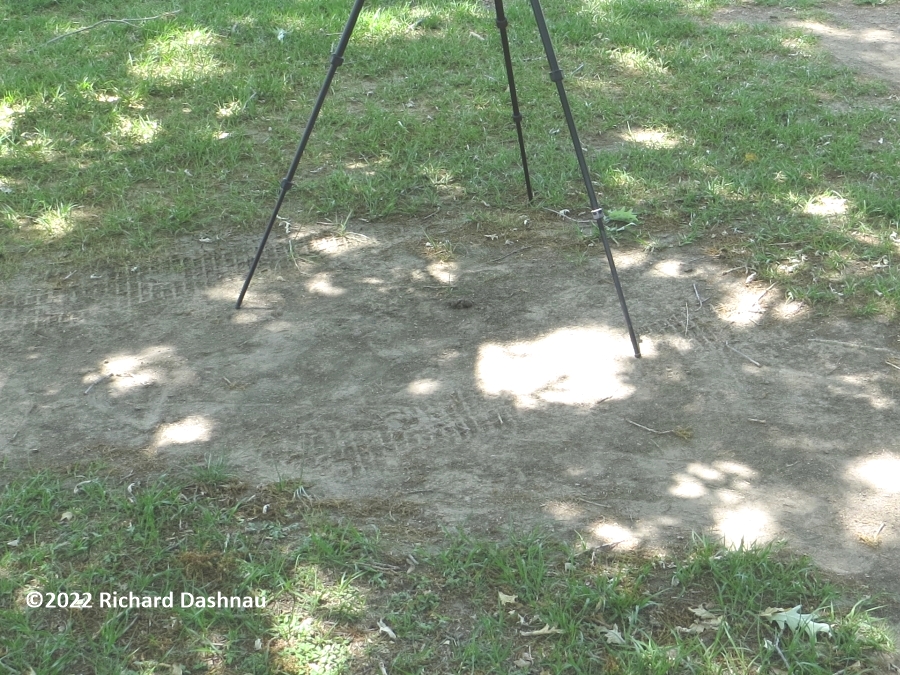
From BBSP on 04/10/2022.
I was leading the Creekfield Hike when we got to the small
bridge. The lake has been very, very shallow lately. When I
looked over the
bridge rail while interpreting for the hike, I was a bit
saddened by seeing the expanse of mud on the West side. But
then I noticed all of the footprints and marks in the mud near
the bridge,
and became very excited. I gave the hike members a brief
description of Ichnology--the study of animal traces. Then
we spent few minutes looking at the animal traces in the
mud, and
trying to figure out what had gone by. The Creekfield hike
isn't normally defined by strict time limit, but I had
signed up for another task in an hour, so I had to move
the hike along. But we
had some fun anyway...and we encountered more tracks by
the pier--and I forgot to take pictures of those. I now have a page dedicated to Ichnology, but
I'll summarize here: While observing
animals as they act, we can learn about their behavior.
But as animals move through the environment, they can
effect it--by leaving footprints, scrapes, burrows, poop,
etc. These traces can
also be clues to animal behavior. One footprint by
itself can give some hints about what made it; but a
series of footprints can show if the animal was running,
hopping, or where it went.
Following a track in either direction lead to a burrow, or
to remains of what it left, etc. So, here are a
couple sets of photos from the bridge.
The
first
set is actually 3 zoomed views of the same spot. In the
first, the big, curved track is obvious. Theres a set of
tracks crossing that one. But in the closest view, we
can see a lot of
traffic and activity. I can try and guess what made
some of the tracks. Although the thick track was pretty big
(maybe 5 inches across at least), I know it wasn't an
alligator, because the feet are
round (no prominant toes) and the steps are too close
together; and there's no tail drag mark. That looks
like a big turtle walked out and moved "up" in the picture.
Turtles take very short steps,
have short toes, and I think the bottom of its shell
dragged across the mud because its feet sunk into the mud.
The large bird that crossed from left to right was not
a duck (no webbing),
or a coot (narrow toes); but probably a heron or egret, or
ibis; because 1 long thin toe pointing backwards. I
think the "splattery" marks were just made by stones tossed
into the mud.
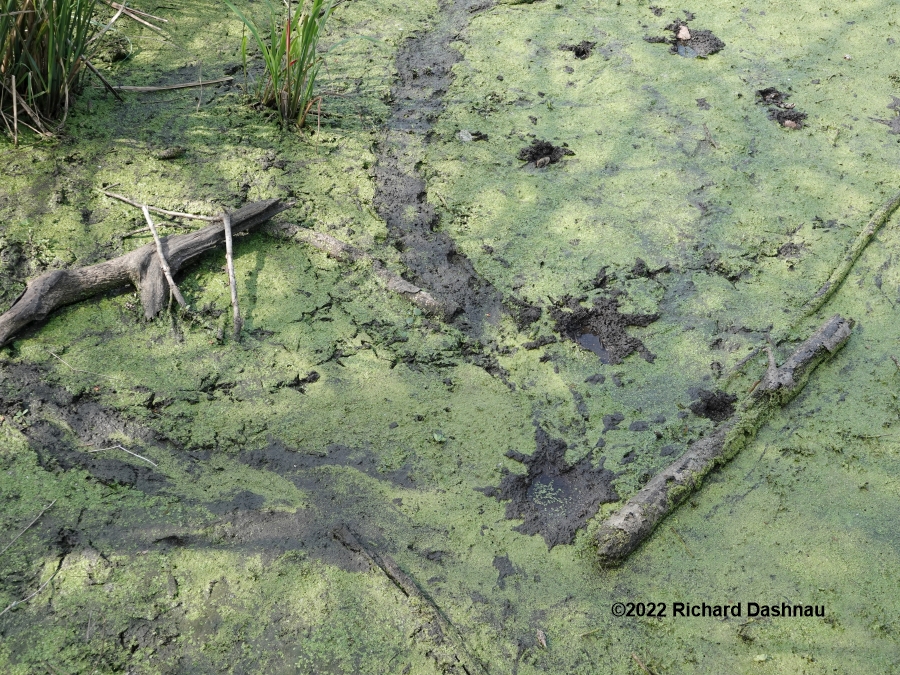
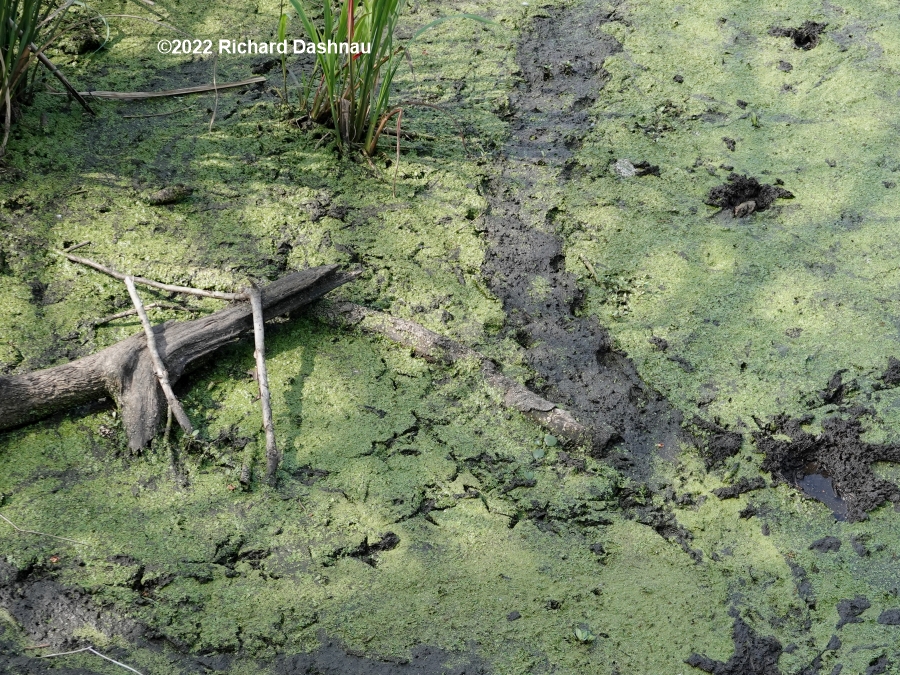
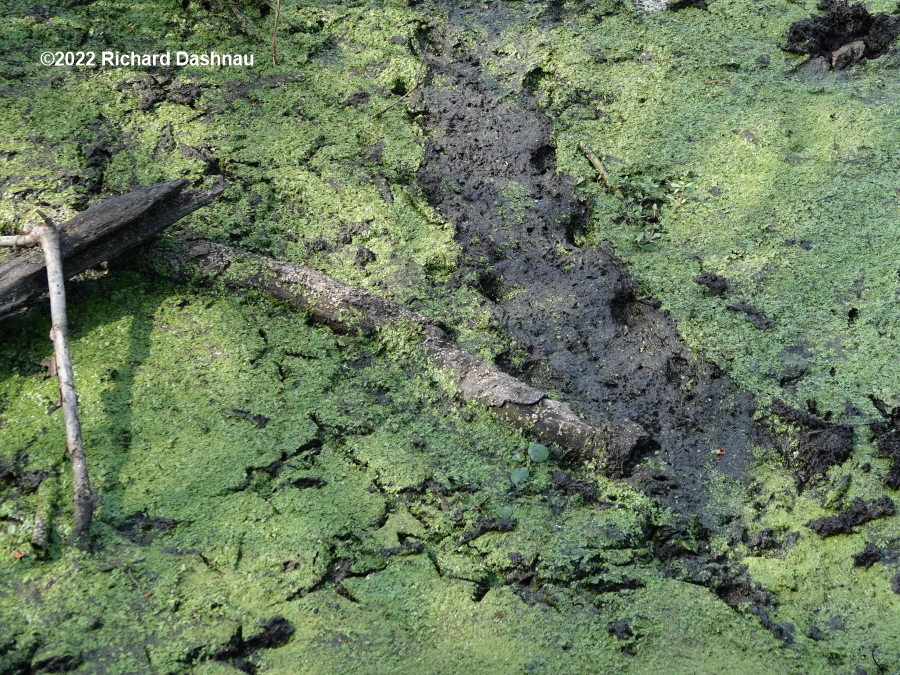
Then I took
these pictures just a bit too the left of the first one. The
left end of that stick show in them. I noticed all the small
holes around the tracks. And I think that those are marks
made by the birds
beaks as they probed the mud. I could not get closer to the
tracks to place anything for scale, and the lighting wasn't
good enough for better zoom shots. Still, the marks
seem to be arragned in pairs,
probably from upper and lower beak being pushed into the
mud. Also, this added observation may help identify at least
on of the trackmakers as an Ibis. Ibises spend most of
their foraging time
stabbing their downward-bent beaks into water and mud. Other
birds also probe, but I suspect this was an Ibis. There are
also at least 3 other "tractor-style" traces. One is large,
like the in the photos
above, but two are smaller (maybe 3 inches across).
The prints are also close together, and I suspect they
were smaller turtles. Look at the pictures, and
imagine how those traces came to be in
the mud. Birds walking (not hopping-by the way-another
clue), probing the mud; while turtles waddle through.
Figuring out such signs can be very interesting and
entertaining.
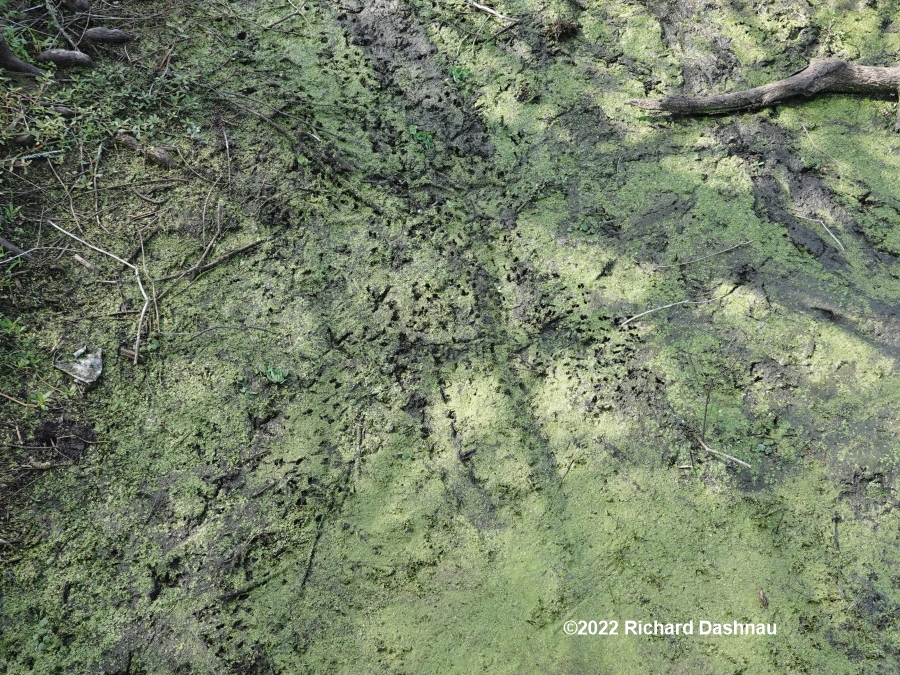
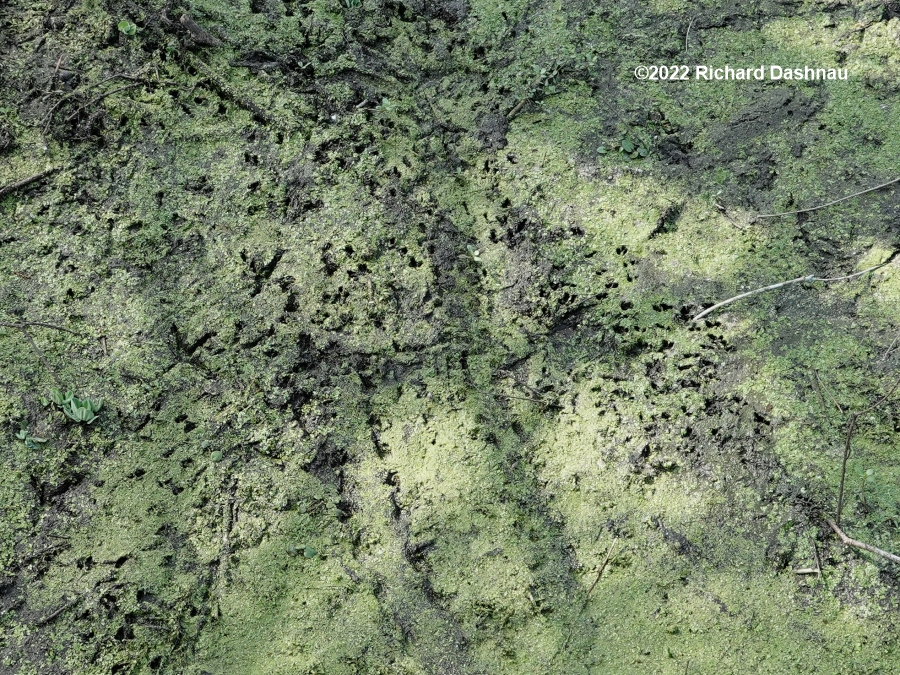
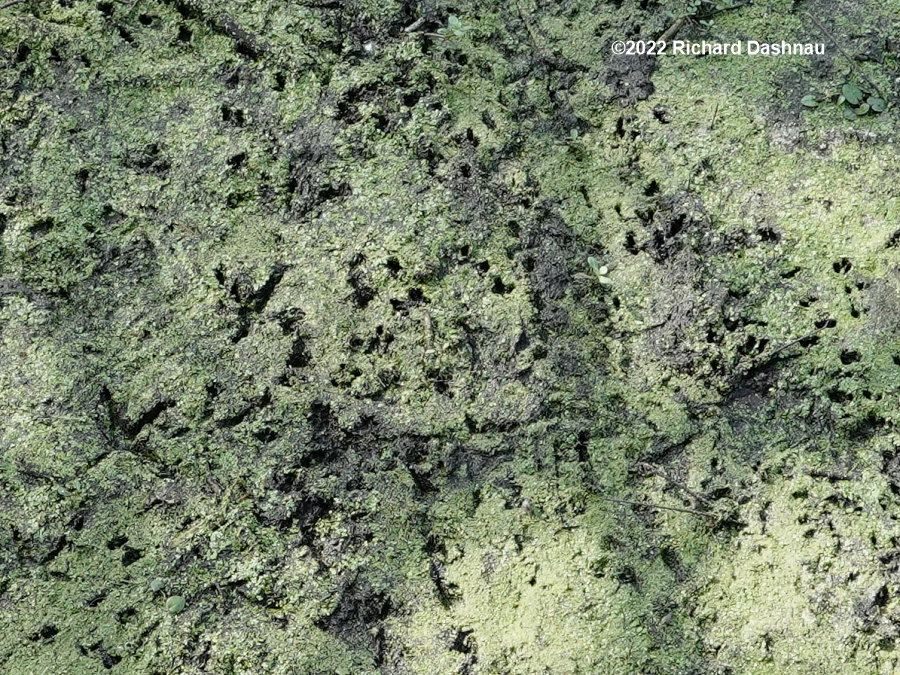
Here's
something that appeared on 40-Acre Lake trail on 10/10/2021.
Yes, it's feces, poop, scat, or stool. At first thought,
it is just evidence that an animal left a "sculpture" on the
trail.
But, this
sculpture was left by an alligator. Since most people
aren't lucky enough to move around in alligator habitat; most
people don't get to see this. Usually, I have to identify
the scat by size, color, texture, etc.. But this
sculpture was signed by the "artist"! That squiggle on the
trail leading to it(or from it) is a drag mark left by the
alligator's tail.
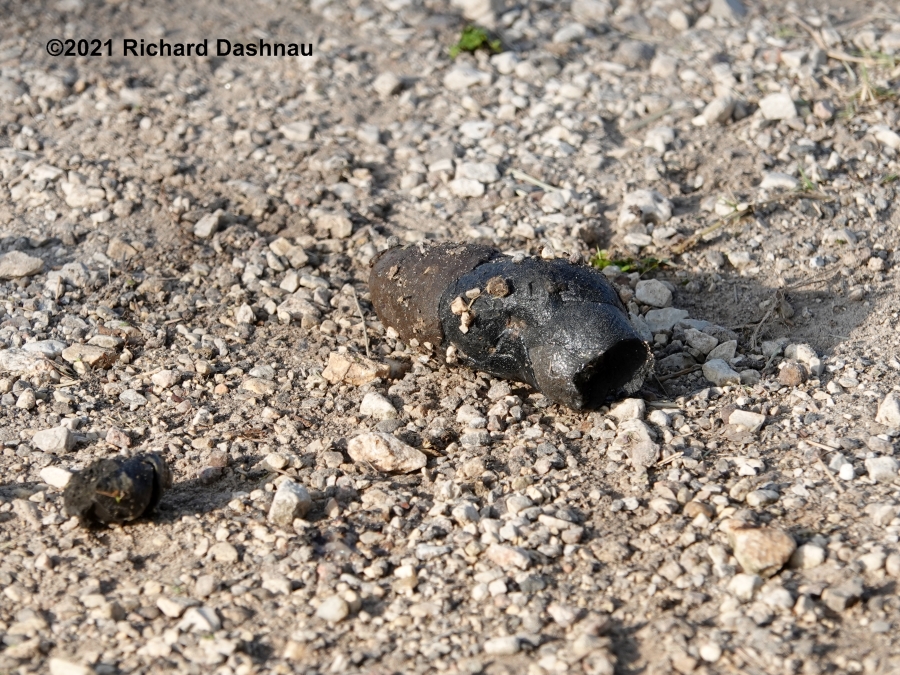
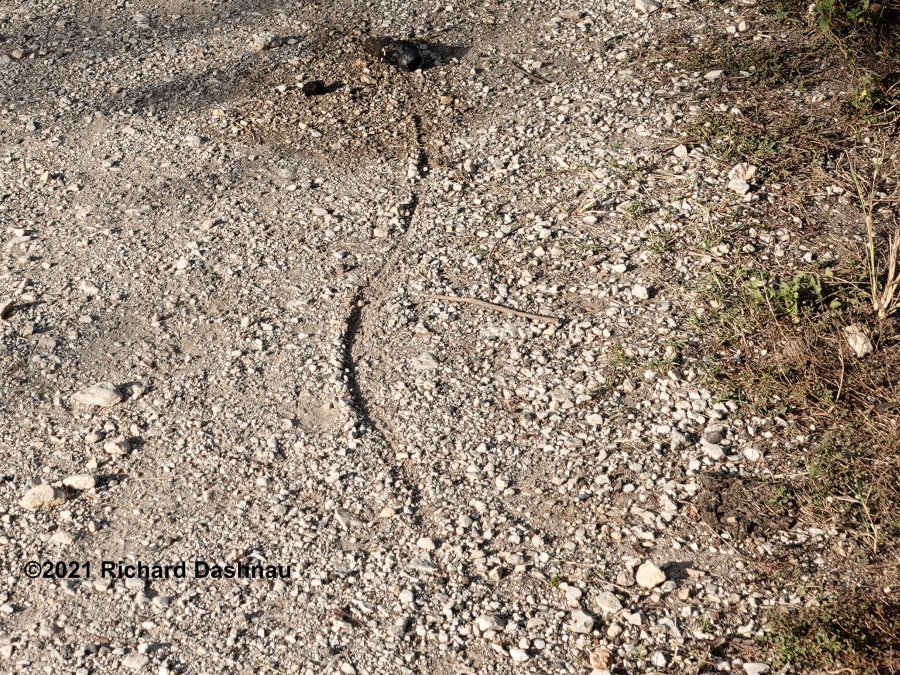
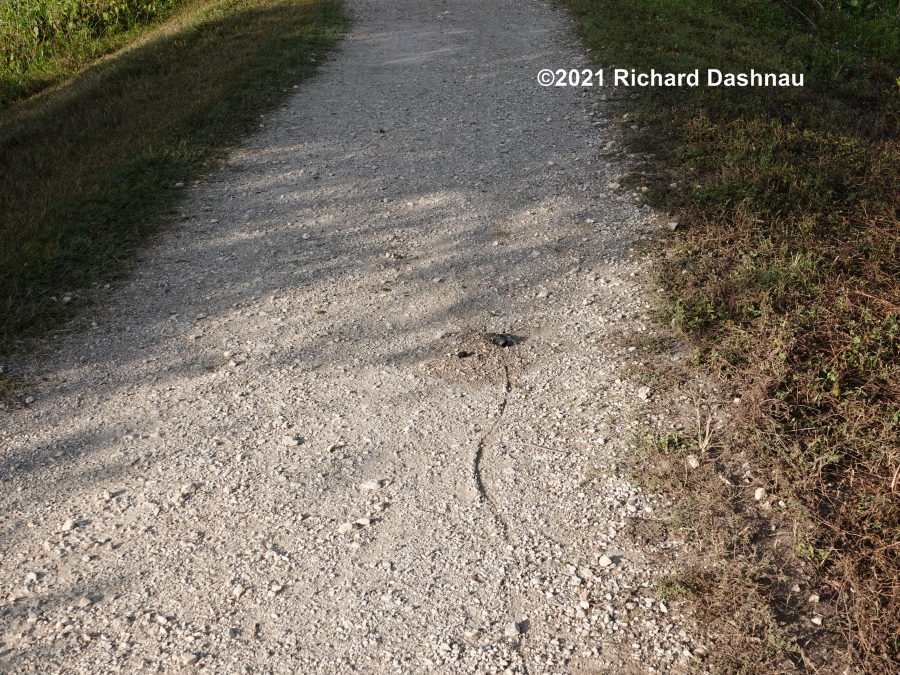
Go to
Ichnology page 2
Go to
Ichnology page 1
Go to
Ichnology
page 4 (this has the most recent observations).
Go
back to my home page, Welcome
to
rickubis.com
Go
back to the RICKUBISCAM
page.


























































































